
MCP2Lambda
Run any AWS Lambda function as a Large Language Model (LLM) tool without code changes using Anthropic's Model Context Protocol (MCP).
Stars: 57
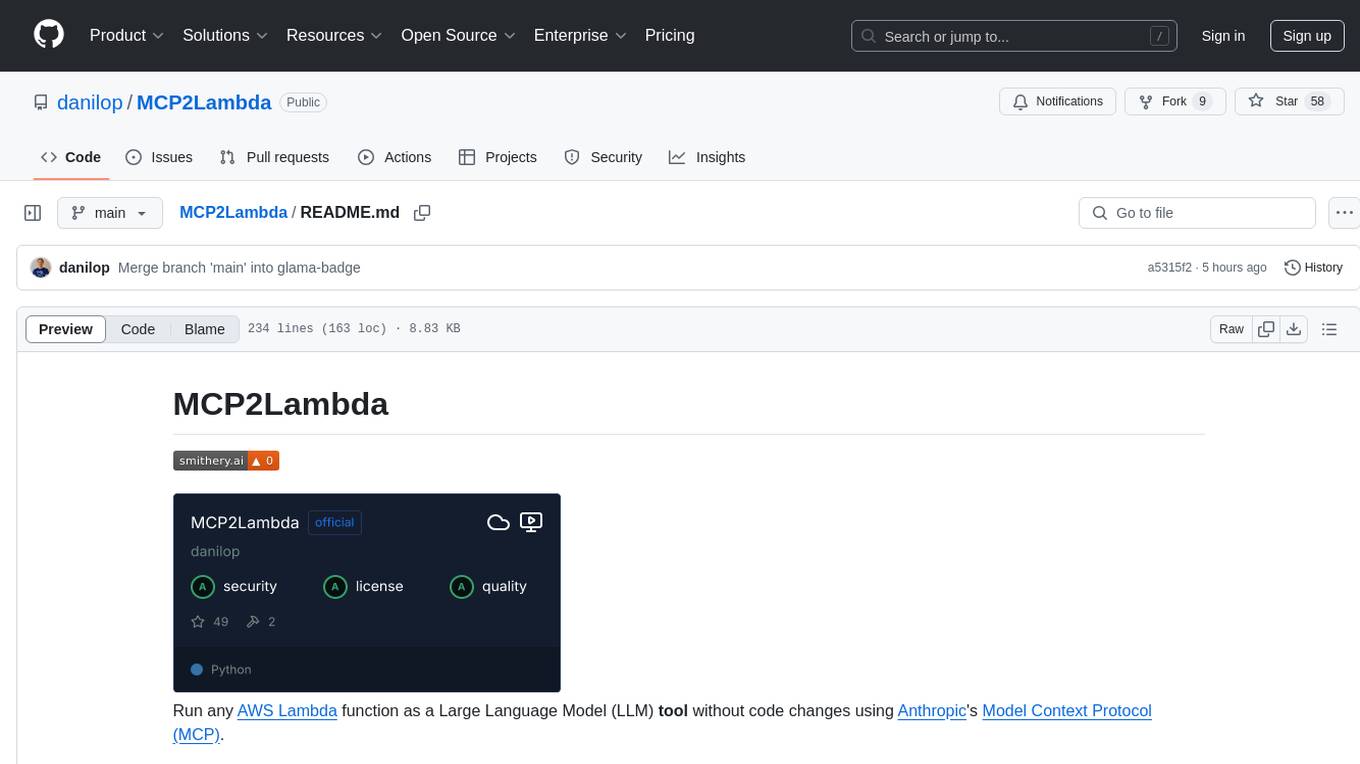
MCP2Lambda is a server that acts as a bridge between MCP clients and AWS Lambda functions, allowing generative AI models to access and run Lambda functions as tools. It enables Large Language Models (LLMs) to interact with Lambda functions without code changes, providing access to private resources, AWS services, private networks, and the public internet. The server supports autodiscovery of Lambda functions and their invocation by name with parameters. It standardizes AI model access to external tools using the MCP protocol.
README:
Run any AWS Lambda function as a Large Language Model (LLM) tool without code changes using Anthropic's Model Context Protocol (MCP).
graph LR
A[Model] <--> B[MCP Client]
B <--> C["MCP2Lambda<br>(MCP Server)"]
C <--> D[Lambda Function]
D <--> E[Other AWS Services]
D <--> F[Internet]
D <--> G[VPC]
style A fill:#f9f,stroke:#333,stroke-width:2px
style B fill:#bbf,stroke:#333,stroke-width:2px
style C fill:#bfb,stroke:#333,stroke-width:4px
style D fill:#fbb,stroke:#333,stroke-width:2px
style E fill:#fbf,stroke:#333,stroke-width:2px
style F fill:#dff,stroke:#333,stroke-width:2px
style G fill:#ffd,stroke:#333,stroke-width:2pxThis MCP server acts as a bridge between MCP clients and AWS Lambda functions, allowing generative AI models to access and run Lambda functions as tools. This is useful, for example, to access private resources such as internal applications and databases without the need to provide public network access. This approach allows the model to use other AWS services, private networks, and the public internet.
From a security perspective, this approach implements segregation of duties by allowing the model to invoke the Lambda functions but not to access the other AWS services directly. The client only needs AWS credentials to invoke the Lambda functions. The Lambda functions can then interact with other AWS services (using the function role) and access public or private networks.
The MCP server gives access to two tools:
-
The first tool can autodiscover all Lambda functions in your account that match a prefix or an allowed list of names. This tool shares the names of the functions and their descriptions with the model.
-
The second tool allows to invoke those Lambda functions by name passing the required parameters.
No code changes are required. You should change these configurations to improve results:
The gateway supports two different strategies for handling Lambda functions:
-
Pre-Discovery Mode (default: enabled): Registers each Lambda function as an individual tool at startup. This provides a more intuitive interface where each function appears as its own named tool.
-
Generic Mode: Uses two generic tools (
list_lambda_functionsandinvoke_lambda_function) to interact with Lambda functions.
You can control this behavior through:
- Environment variable:
PRE_DISCOVERY=true|false - CLI flag:
--no-pre-discovery(disables pre-discovery mode)
Example:
# Disable pre-discovery mode
export PRE_DISCOVERY=false
python main.py
# Or using CLI flag to disable pre-discovery
python main.py --no-pre-discovery-
To provide the MCP client with the knowledge to use a Lambda function, the description of the Lambda function should indicate what the function does and which parameters it uses. See the sample functions for a quick demo and more details.
-
To help the model use the tools available via AWS Lambda, you can add something like this to your system prompt:
Use the AWS Lambda tools to improve your answers.
MCP2Lambda enables LLMs to interact with AWS Lambda functions as tools, extending their capabilities beyond text generation. This allows models to:
- Access real-time and private data, including data sources in your VPCs
- Execute custom code using a Lambda function as sandbox environment
- Interact with external services and APIs using Lambda functions internet access (and bandwidth)
- Perform specialized calculations or data processing
The server uses the MCP protocol, which standardizes the way AI models can access external tools.
By default, only functions whose name starts with mcp2lambda- will be available to the model.
- Python 3.12 or higher
- AWS account with configured credentials
- AWS Lambda functions (sample functions provided in the repo)
- An application using Amazon Bedrock with the Converse API
- An MCP-compatible client like Claude Desktop
To install MCP2Lambda for Claude Desktop automatically via Smithery:
npx -y @smithery/cli install @danilop/MCP2Lambda --client claude-
Clone the repository:
git clone https://github.com/yourusername/mcp2lambda.git cd mcp2lambda -
Configure AWS credentials. For example, using the AWS CLI:
aws configure
This repository includes three sample Lambda functions that demonstrate different use cases. These functions have basic permissions and can only write to CloudWatch logs.
Retrieves a customer ID based on an email address. This function takes an email parameter and returns the associated customer ID, demonstrating how to build simple lookup tools. The function is hard coded to reply to the [email protected] email address. For example, you can ask the model to get the customer ID for the email [email protected].
Retrieves detailed customer information based on a customer ID. This function returns customer details like name, email, and status, showing how Lambda can provide context-specific data. The function is hard coded to reply to the customer ID returned by the previous function. For example, you can ask the model to "Get the customer status for email [email protected]". This will use both functions to get to the result.
Executes arbitrary Python code within a Lambda sandbox environment. This powerful function allows Claude to write and run Python code to perform calculations, data processing, or other operations not built into the model. For example, you can ask the model to "Calculate the number of prime numbers between 1 and 10, 1 and 100, and so on up to 1M".
The repository includes sample Lambda functions in the sample_functions directory.
-
Install the AWS SAM CLI: https://docs.aws.amazon.com/serverless-application-model/latest/developerguide/install-sam-cli.html
-
Deploy the sample functions:
cd sample_functions sam build sam deploy
The sample functions will be deployed with the prefix mcp2lambda-.
MCP2Lambda can also be used with Amazon Bedrock's Converse API, allowing you to use the MCP protocol with any of the models supported by Bedrock.
The mcp_client_bedrock directory contains a client implementation that connects MCP2Lambda to Amazon Bedrock models.
See https://github.com/mikegc-aws/amazon-bedrock-mcp for more information.
- Amazon Bedrock access and permissions to use models like Claude, Mistral, Llama, etc.
- Boto3 configured with appropriate credentials
-
Navigate to the mcp_client_bedrock directory:
cd mcp_client_bedrock -
Install dependencies:
uv pip install -e . -
Run the client:
python main.py
The client is configured to use Anthropic's Claude 3.7 Sonnet by default, but you can modify the model_id in main.py to use other Bedrock models:
# Examples of supported models:
model_id = "us.anthropic.claude-3-7-sonnet-20250219-v1:0"
#model_id = "us.amazon.nova-pro-v1:0"You can also customize the system prompt in the same file to change how the model behaves.
-
Start the MCP2Lambda server in one terminal:
cd mcp2lambda uv run main.py -
Run the Bedrock client in another terminal:
cd mcp_client_bedrock python main.py -
Interact with the model through the command-line interface. The model will have access to the Lambda functions deployed earlier.
Add the following to your Claude Desktop configuration file:
{
"mcpServers": {
"mcp2lambda": {
"command": "uv",
"args": [
"--directory",
"<full path to the mcp2lambda directory>",
"run",
"main.py"
]
}
}
}To help the model use tools via AWS Lambda, in your settings profile, you can add to your personal preferences a sentence like:
Use the AWS Lambda tools to improve your answers.
Start the MCP server locally:
cd mcp2lambda
uv run main.pyFor Tasks:
Click tags to check more tools for each tasksFor Jobs:
Alternative AI tools for MCP2Lambda
Similar Open Source Tools

MCP2Lambda
MCP2Lambda is a server that acts as a bridge between MCP clients and AWS Lambda functions, allowing generative AI models to access and run Lambda functions as tools. It enables Large Language Models (LLMs) to interact with Lambda functions without code changes, providing access to private resources, AWS services, private networks, and the public internet. The server supports autodiscovery of Lambda functions and their invocation by name with parameters. It standardizes AI model access to external tools using the MCP protocol.
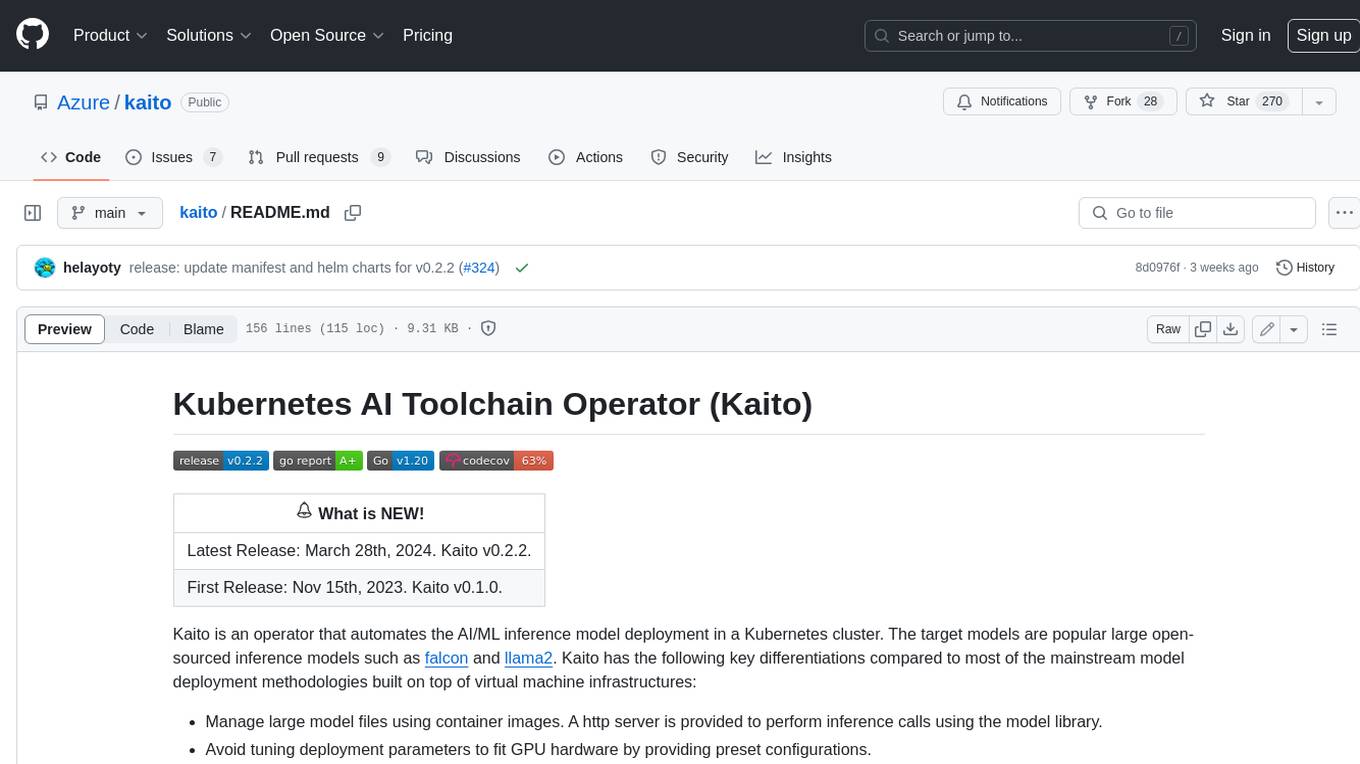
kaito
Kaito is an operator that automates the AI/ML inference model deployment in a Kubernetes cluster. It manages large model files using container images, avoids tuning deployment parameters to fit GPU hardware by providing preset configurations, auto-provisions GPU nodes based on model requirements, and hosts large model images in the public Microsoft Container Registry (MCR) if the license allows. Using Kaito, the workflow of onboarding large AI inference models in Kubernetes is largely simplified.
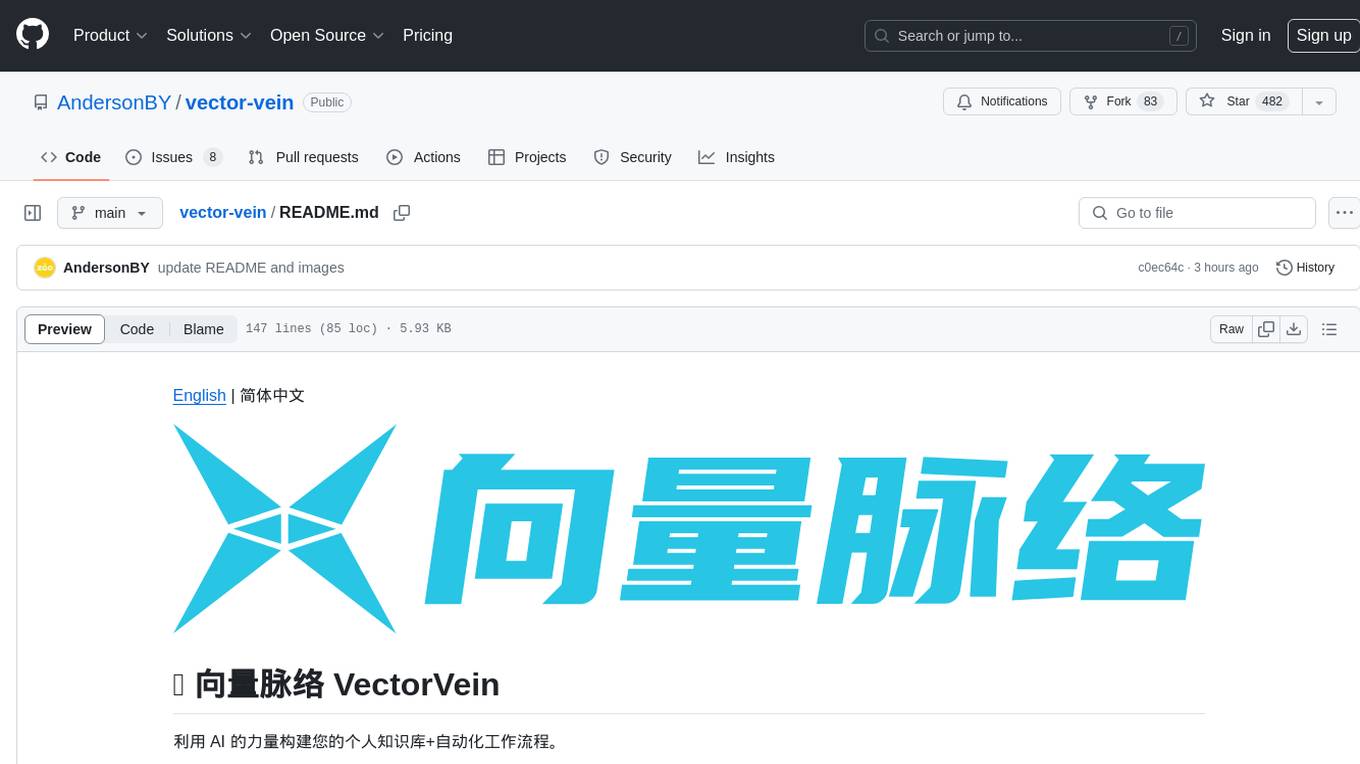
vector-vein
VectorVein is a no-code AI workflow software inspired by LangChain and langflow, aiming to combine the powerful capabilities of large language models and enable users to achieve intelligent and automated daily workflows through simple drag-and-drop actions. Users can create powerful workflows without the need for programming, automating all tasks with ease. The software allows users to define inputs, outputs, and processing methods to create customized workflow processes for various tasks such as translation, mind mapping, summarizing web articles, and automatic categorization of customer reviews.
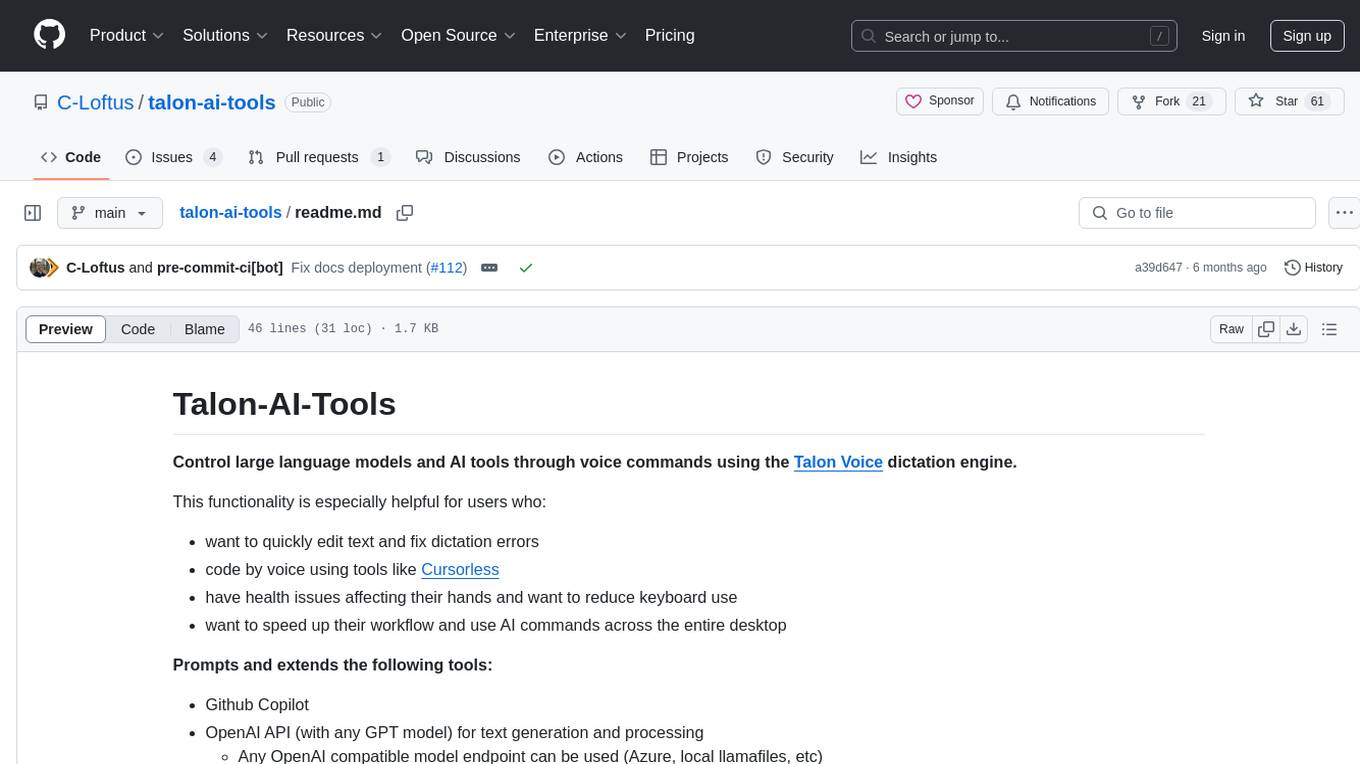
talon-ai-tools
Control large language models and AI tools through voice commands using the Talon Voice dictation engine. This tool is designed to help users quickly edit text, code by voice, reduce keyboard use for those with health issues, and speed up workflow by using AI commands across the desktop. It prompts and extends tools like Github Copilot and OpenAI API for text and image generation. Users can set up the tool by downloading the repo, obtaining an OpenAI API key, and customizing the endpoint URL for preferred models. The tool can be used without an OpenAI key and can be exclusively used with Copilot for those not needing LLM integration.
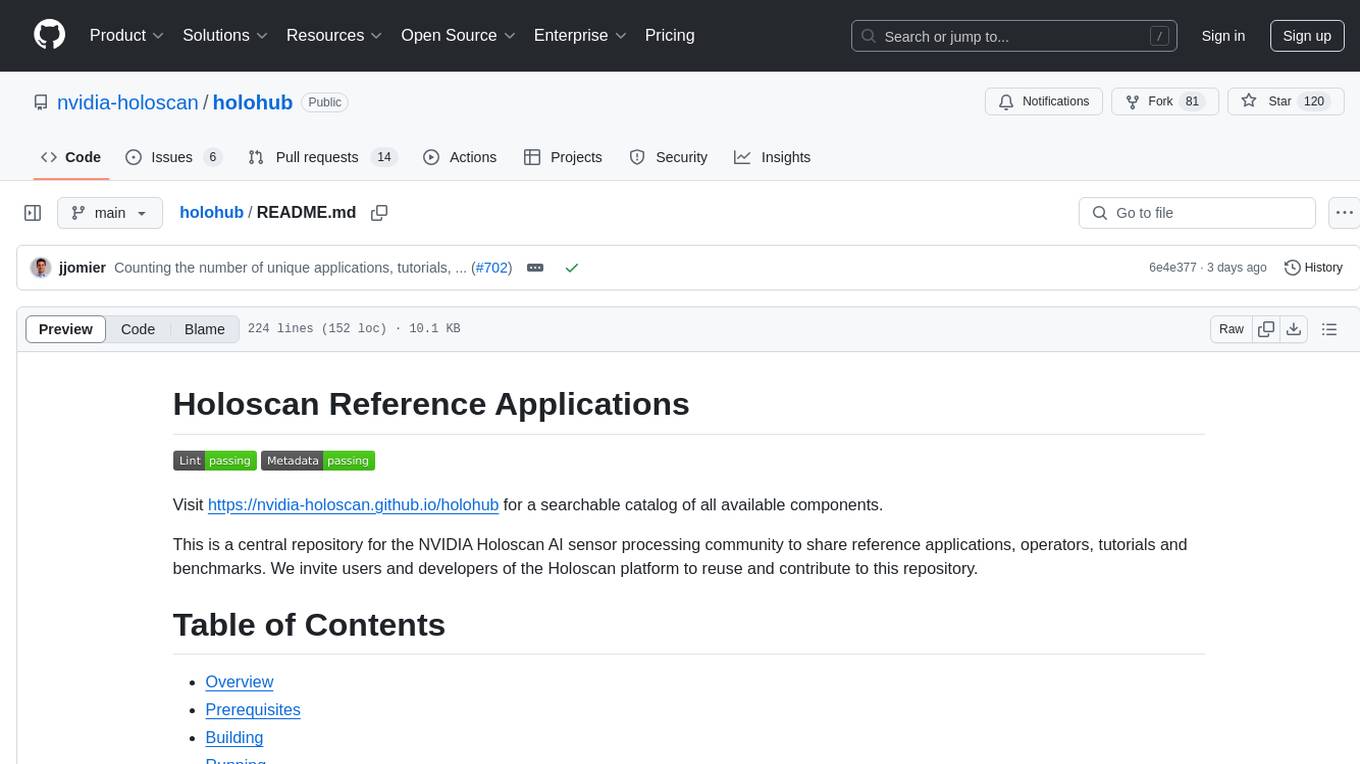
holohub
Holohub is a central repository for the NVIDIA Holoscan AI sensor processing community to share reference applications, operators, tutorials, and benchmarks. It includes example applications, community components, package configurations, and tutorials. Users and developers of the Holoscan platform are invited to reuse and contribute to this repository. The repository provides detailed instructions on prerequisites, building, running applications, contributing, and glossary terms. It also offers a searchable catalog of available components on the Holoscan SDK User Guide website.
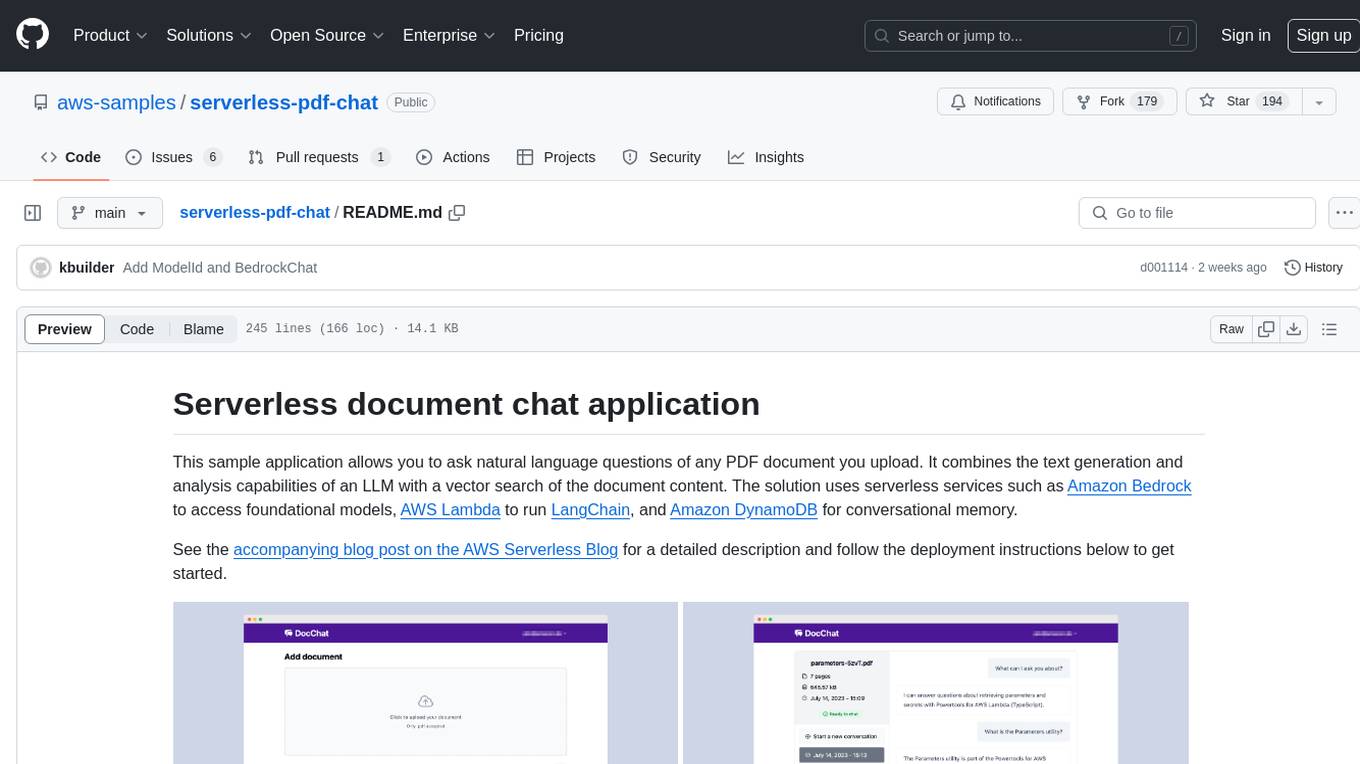
serverless-pdf-chat
The serverless-pdf-chat repository contains a sample application that allows users to ask natural language questions of any PDF document they upload. It leverages serverless services like Amazon Bedrock, AWS Lambda, and Amazon DynamoDB to provide text generation and analysis capabilities. The application architecture involves uploading a PDF document to an S3 bucket, extracting metadata, converting text to vectors, and using a LangChain to search for information related to user prompts. The application is not intended for production use and serves as a demonstration and educational tool.
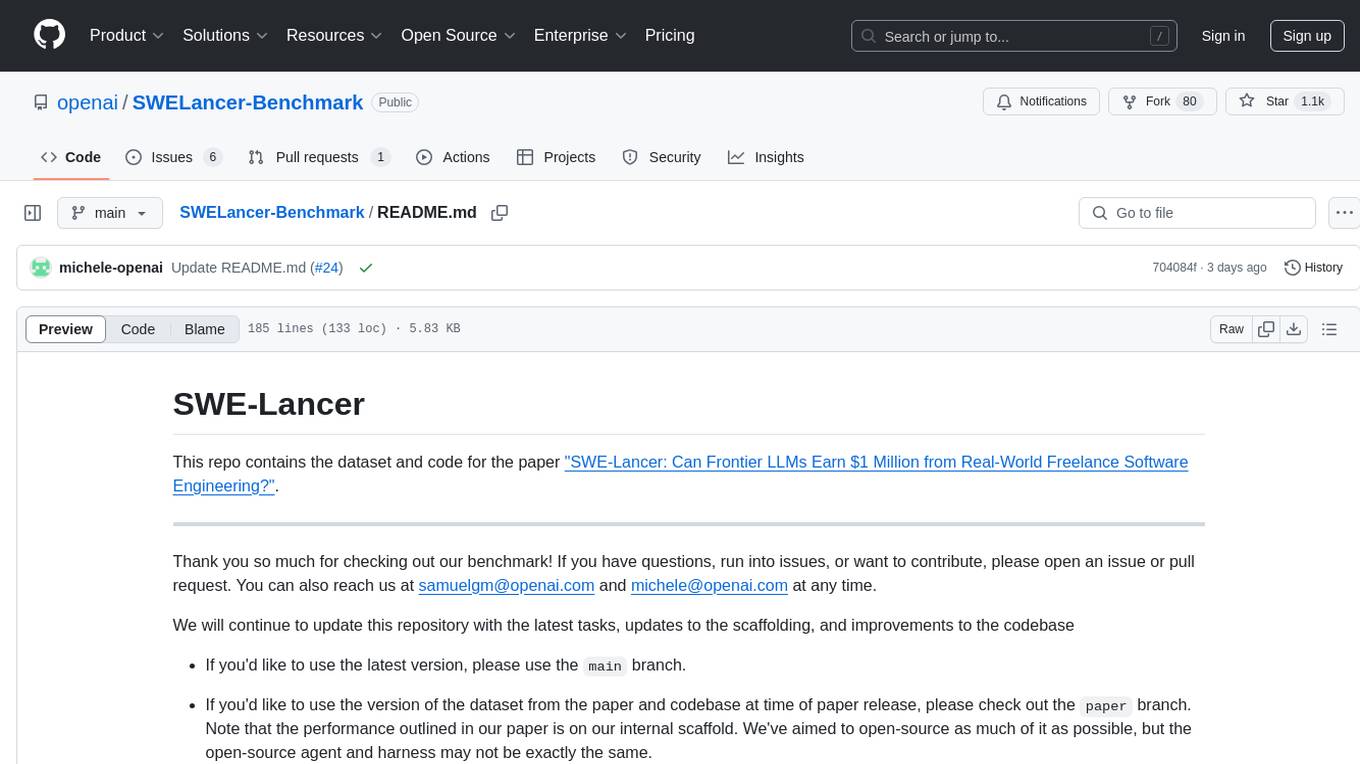
SWELancer-Benchmark
SWE-Lancer is a benchmark repository containing datasets and code for the paper 'SWE-Lancer: Can Frontier LLMs Earn $1 Million from Real-World Freelance Software Engineering?'. It provides instructions for package management, building Docker images, configuring environment variables, and running evaluations. Users can use this tool to assess the performance of language models in real-world freelance software engineering tasks.
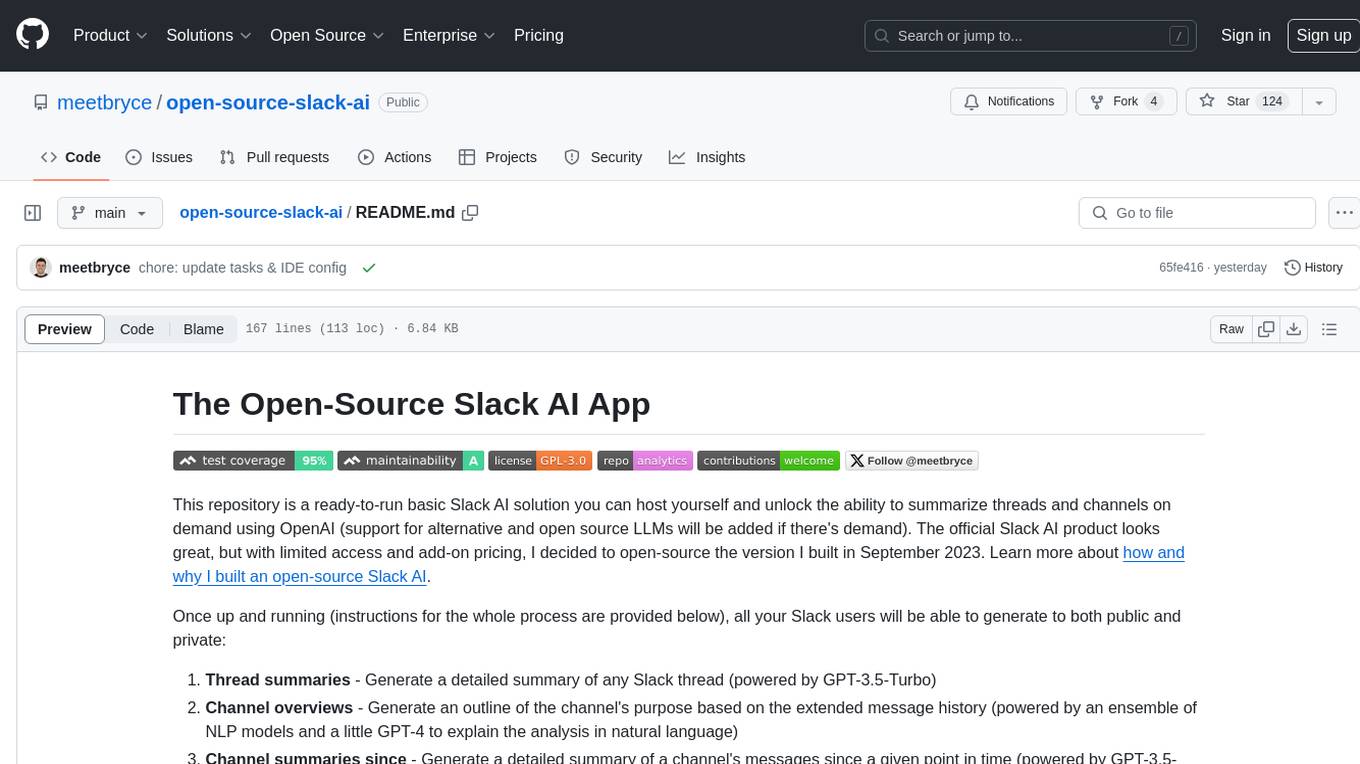
open-source-slack-ai
This repository provides a ready-to-run basic Slack AI solution that allows users to summarize threads and channels using OpenAI. Users can generate thread summaries, channel overviews, channel summaries since a specific time, and full channel summaries. The tool is powered by GPT-3.5-Turbo and an ensemble of NLP models. It requires Python 3.8 or higher, an OpenAI API key, Slack App with associated API tokens, Poetry package manager, and ngrok for local development. Users can customize channel and thread summaries, run tests with coverage using pytest, and contribute to the project for future enhancements.
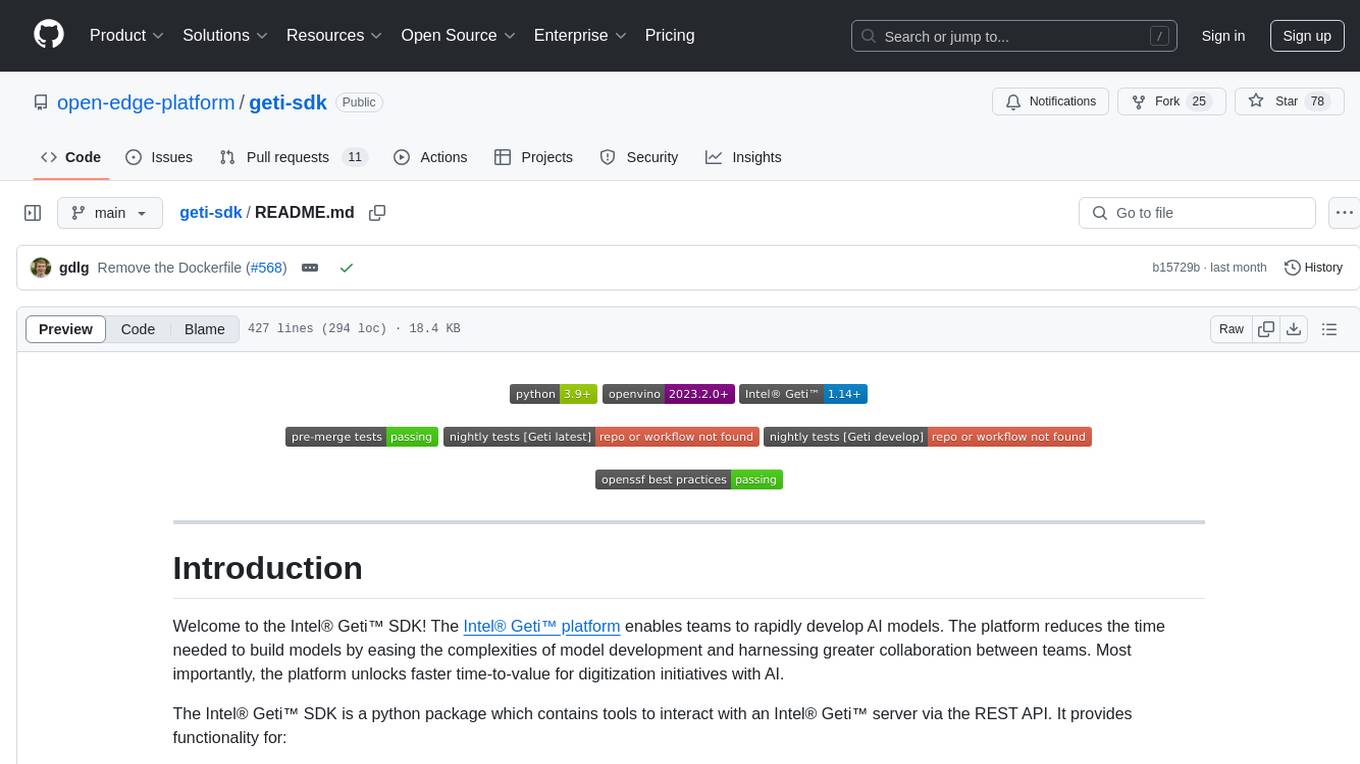
geti-sdk
The Intel® Geti™ SDK is a python package that enables teams to rapidly develop AI models by easing the complexities of model development and fostering collaboration. It provides tools to interact with an Intel® Geti™ server via the REST API, allowing for project creation, downloading, uploading, deploying for local inference with OpenVINO, configuration management, training job monitoring, media upload, and prediction. The repository also includes tutorial-style Jupyter notebooks demonstrating SDK usage.
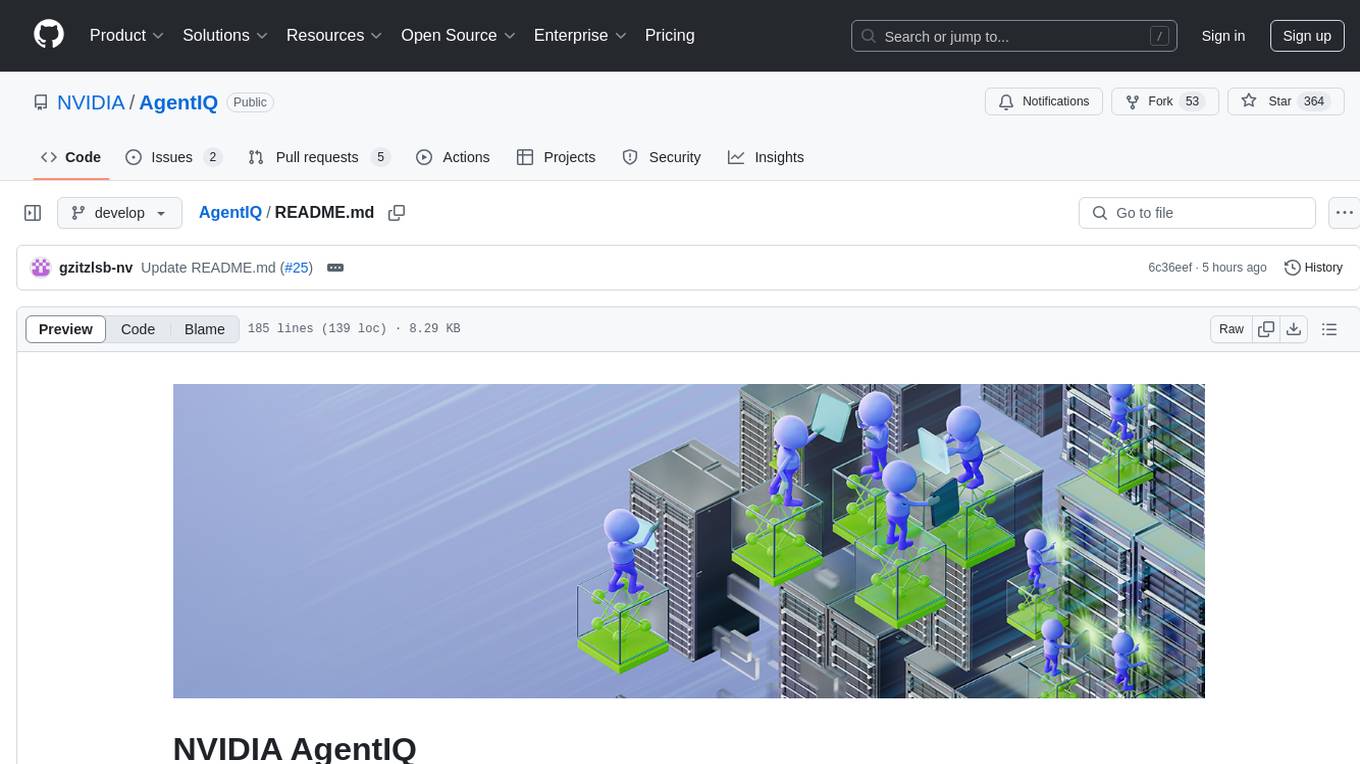
AgentIQ
AgentIQ is a flexible library designed to seamlessly integrate enterprise agents with various data sources and tools. It enables true composability by treating agents, tools, and workflows as simple function calls. With features like framework agnosticism, reusability, rapid development, profiling, observability, evaluation system, user interface, and MCP compatibility, AgentIQ empowers developers to move quickly, experiment freely, and ensure reliability across agent-driven projects.
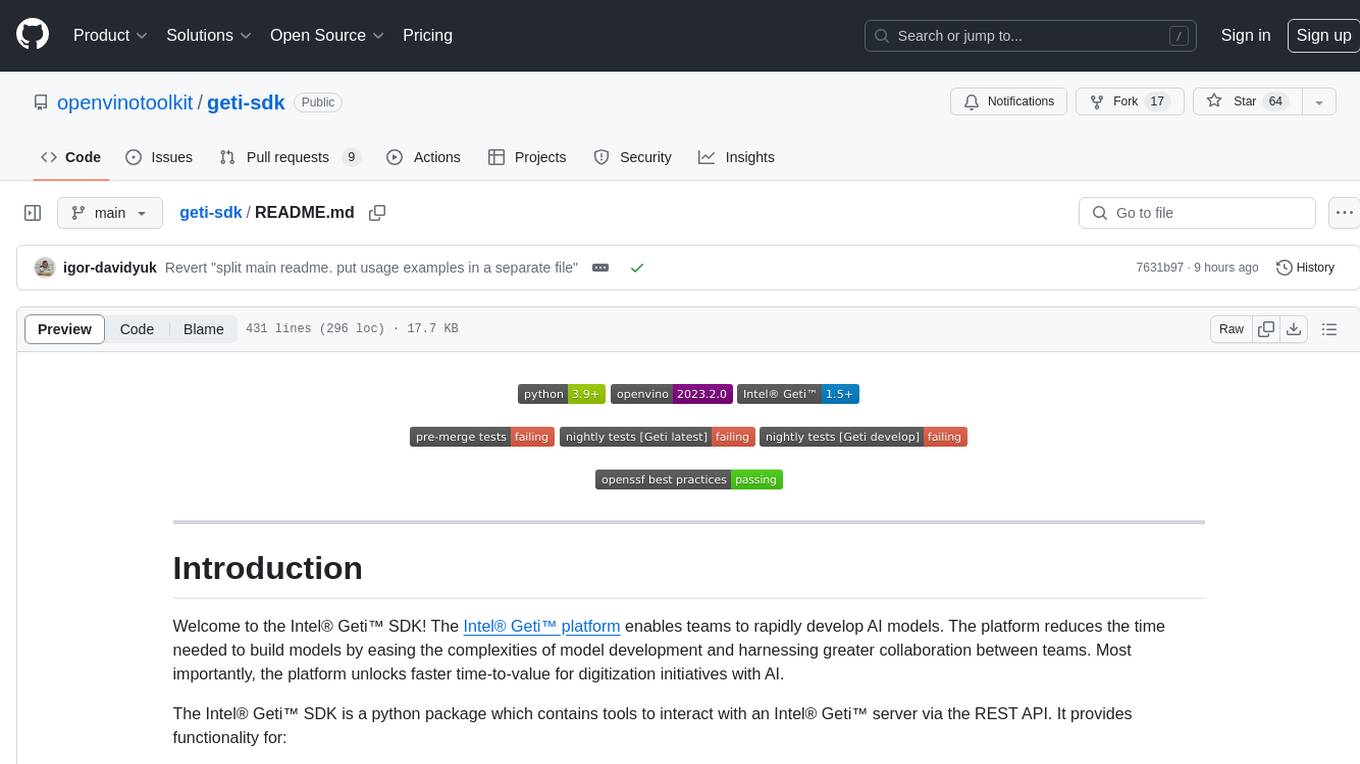
geti-sdk
The Intel® Geti™ SDK is a python package that enables teams to rapidly develop AI models by easing the complexities of model development and enhancing collaboration between teams. It provides tools to interact with an Intel® Geti™ server via the REST API, allowing for project creation, downloading, uploading, deploying for local inference with OpenVINO, setting project and model configuration, launching and monitoring training jobs, and media upload and prediction. The SDK also includes tutorial-style Jupyter notebooks demonstrating its usage.
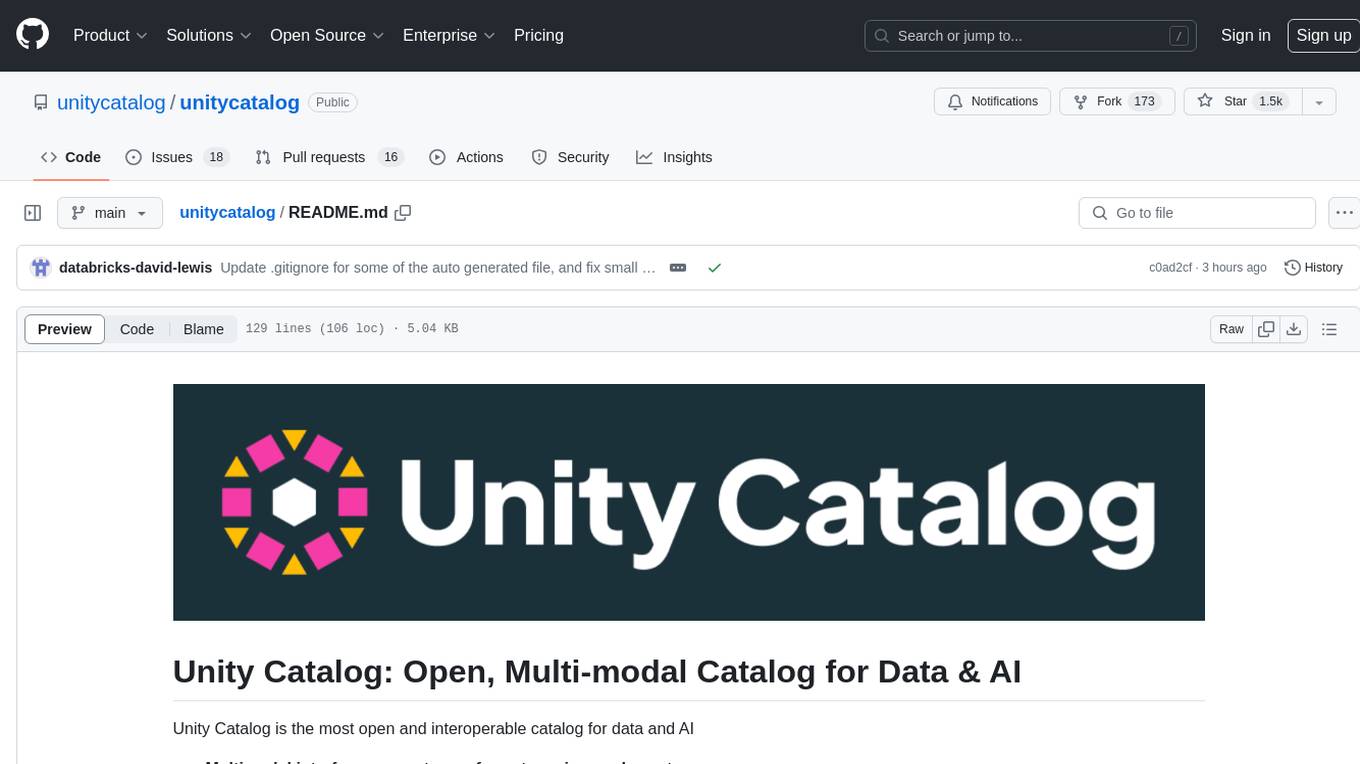
unitycatalog
Unity Catalog is an open and interoperable catalog for data and AI, supporting multi-format tables, unstructured data, and AI assets. It offers plugin support for extensibility and interoperates with Delta Sharing protocol. The catalog is fully open with OpenAPI spec and OSS implementation, providing unified governance for data and AI with asset-level access control enforced through REST APIs.
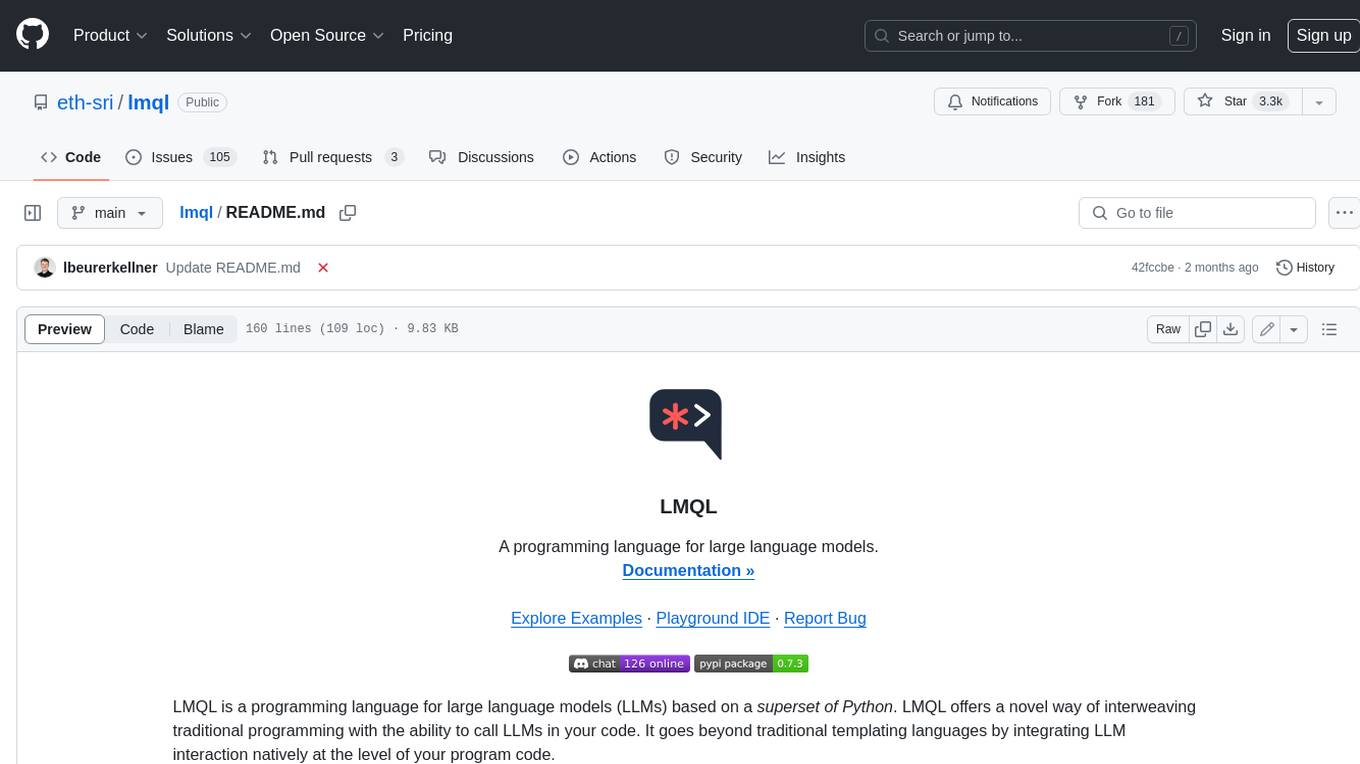
lmql
LMQL is a programming language designed for large language models (LLMs) that offers a unique way of integrating traditional programming with LLM interaction. It allows users to write programs that combine algorithmic logic with LLM calls, enabling model reasoning capabilities within the context of the program. LMQL provides features such as Python syntax integration, rich control-flow options, advanced decoding techniques, powerful constraints via logit masking, runtime optimization, sync and async API support, multi-model compatibility, and extensive applications like JSON decoding and interactive chat interfaces. The tool also offers library integration, flexible tooling, and output streaming options for easy model output handling.
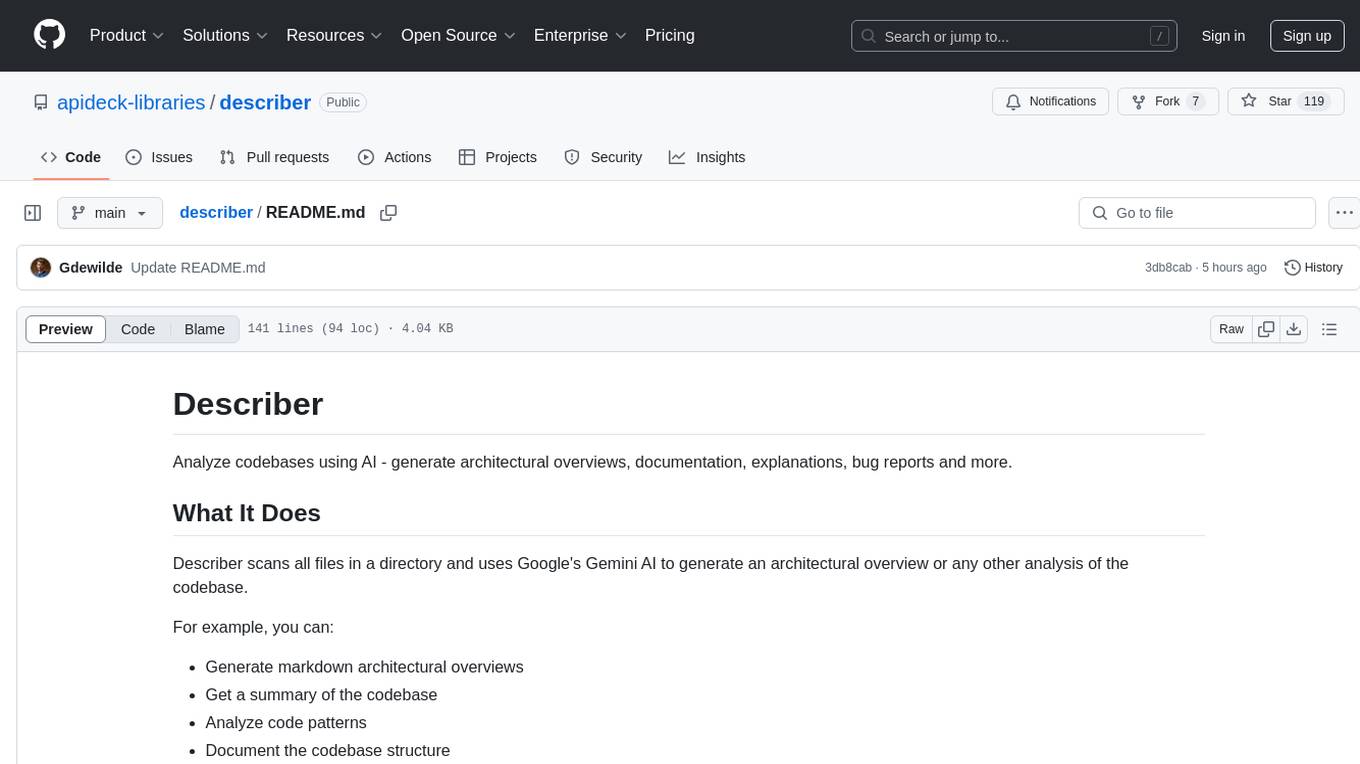
describer
Describer is a tool that analyzes codebases using AI to generate architectural overviews, documentation, explanations, bug reports, and more. It scans all files in a directory and uses Google's Gemini AI to provide insights such as markdown architectural overviews, codebase summaries, code pattern analysis, codebase structure documentation, bug identification, and test idea generation. The tool respects .gitignore rules by default but allows users to include/exclude specific files or patterns for analysis.
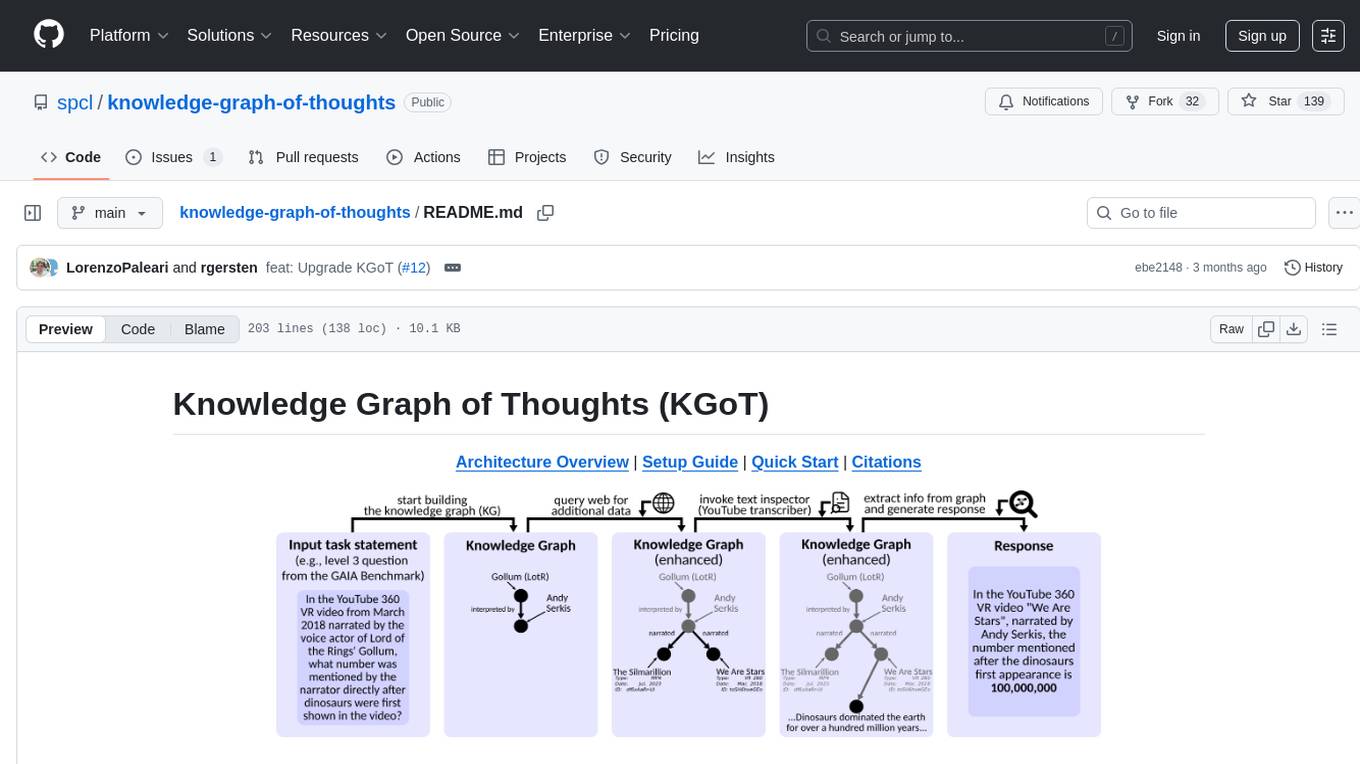
knowledge-graph-of-thoughts
Knowledge Graph of Thoughts (KGoT) is an innovative AI assistant architecture that integrates LLM reasoning with dynamically constructed knowledge graphs (KGs). KGoT extracts and structures task-relevant knowledge into a dynamic KG representation, iteratively enhanced through external tools such as math solvers, web crawlers, and Python scripts. Such structured representation of task-relevant knowledge enables low-cost models to solve complex tasks effectively. The KGoT system consists of three main components: the Controller, the Graph Store, and the Integrated Tools, each playing a critical role in the task-solving process.
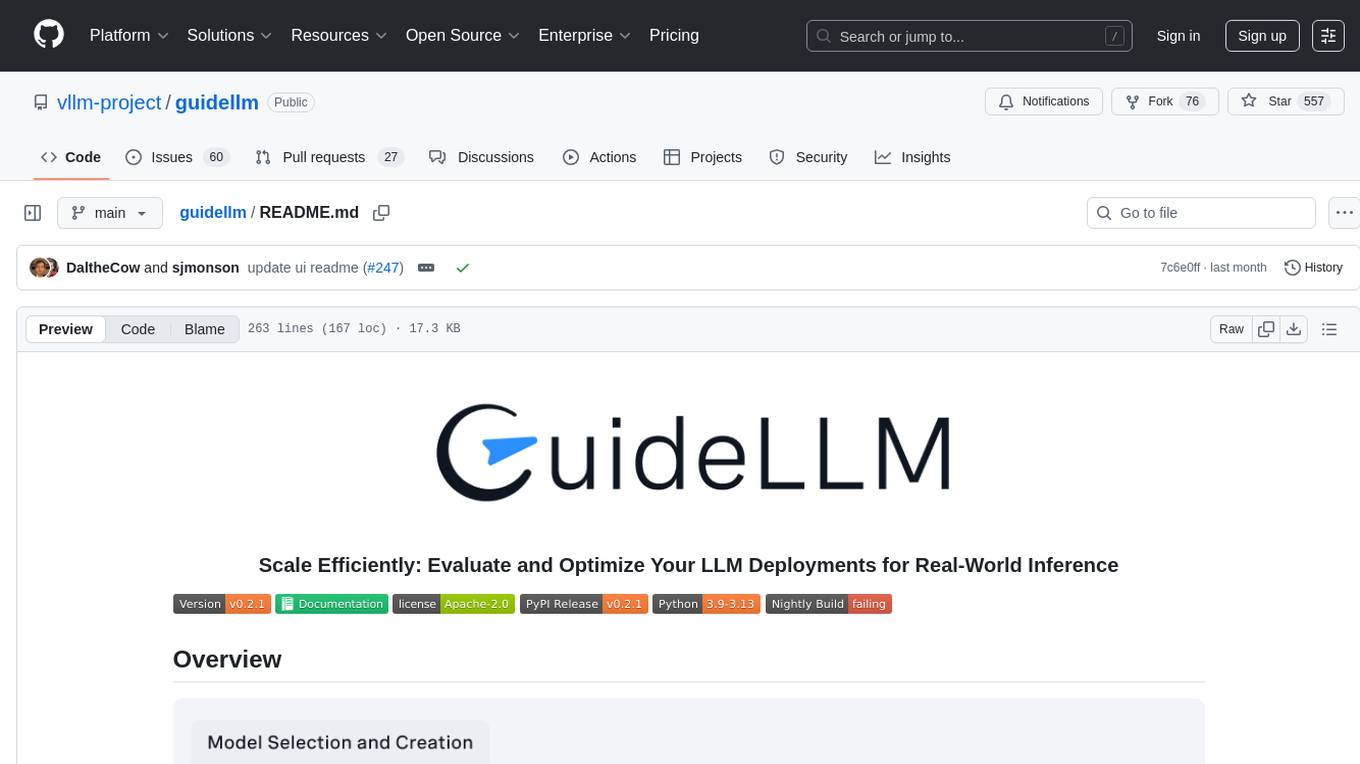
guidellm
GuideLLM is a platform for evaluating and optimizing the deployment of large language models (LLMs). By simulating real-world inference workloads, GuideLLM enables users to assess the performance, resource requirements, and cost implications of deploying LLMs on various hardware configurations. This approach ensures efficient, scalable, and cost-effective LLM inference serving while maintaining high service quality. The tool provides features for performance evaluation, resource optimization, cost estimation, and scalability testing.
For similar tasks

MCP2Lambda
MCP2Lambda is a server that acts as a bridge between MCP clients and AWS Lambda functions, allowing generative AI models to access and run Lambda functions as tools. It enables Large Language Models (LLMs) to interact with Lambda functions without code changes, providing access to private resources, AWS services, private networks, and the public internet. The server supports autodiscovery of Lambda functions and their invocation by name with parameters. It standardizes AI model access to external tools using the MCP protocol.
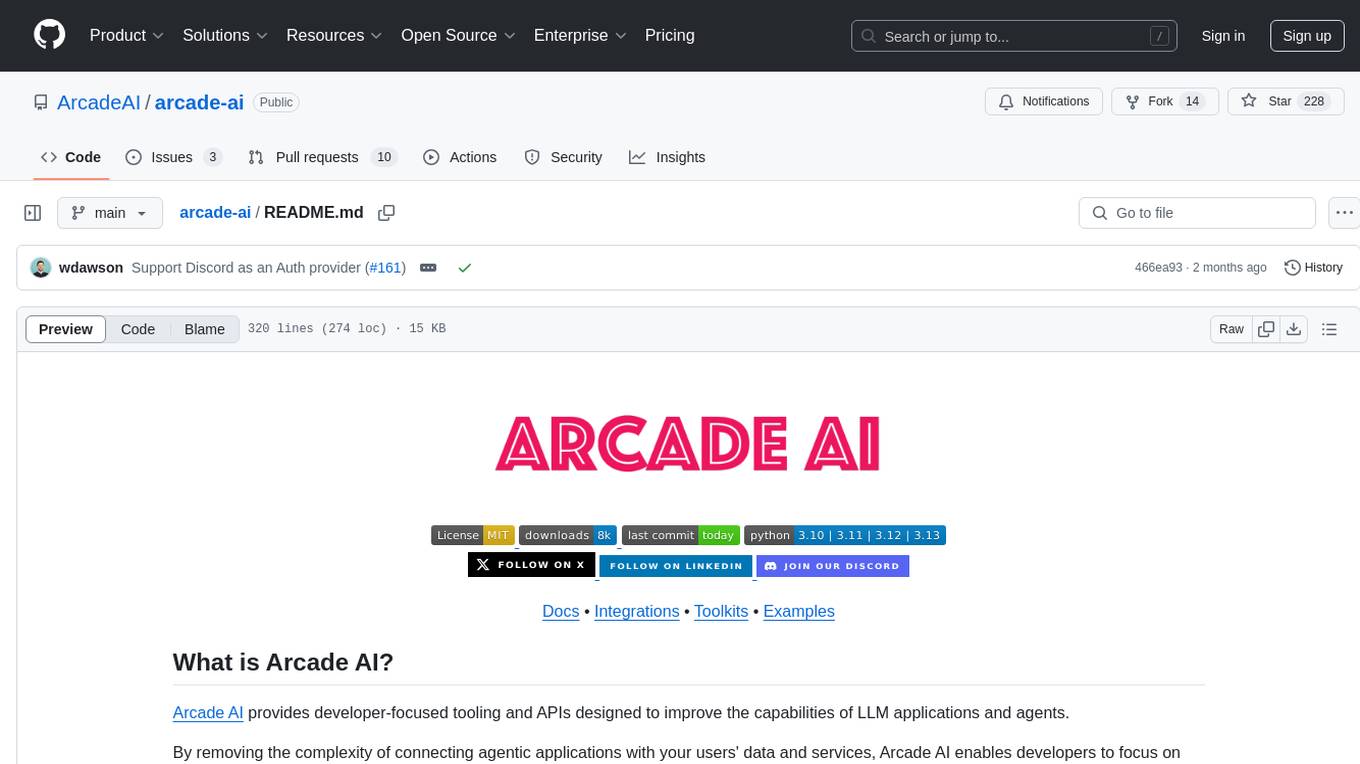
arcade-ai
Arcade AI is a developer-focused tooling and API platform designed to enhance the capabilities of LLM applications and agents. It simplifies the process of connecting agentic applications with user data and services, allowing developers to concentrate on building their applications. The platform offers prebuilt toolkits for interacting with various services, supports multiple authentication providers, and provides access to different language models. Users can also create custom toolkits and evaluate their tools using Arcade AI. Contributions are welcome, and self-hosting is possible with the provided documentation.
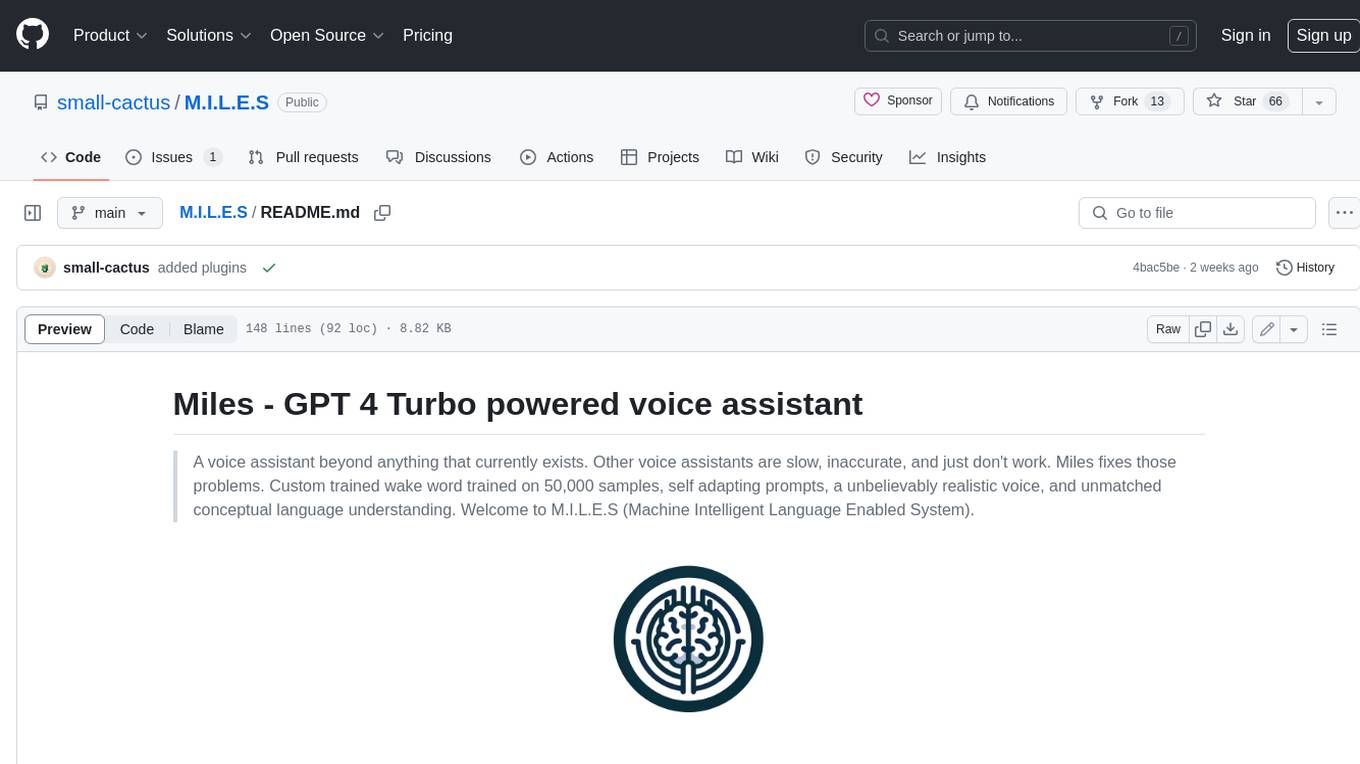
M.I.L.E.S
M.I.L.E.S. (Machine Intelligent Language Enabled System) is a voice assistant powered by GPT-4 Turbo, offering a range of capabilities beyond existing assistants. With its advanced language understanding, M.I.L.E.S. provides accurate and efficient responses to user queries. It seamlessly integrates with smart home devices, Spotify, and offers real-time weather information. Additionally, M.I.L.E.S. possesses persistent memory, a built-in calculator, and multi-tasking abilities. Its realistic voice, accurate wake word detection, and internet browsing capabilities enhance the user experience. M.I.L.E.S. prioritizes user privacy by processing data locally, encrypting sensitive information, and adhering to strict data retention policies.
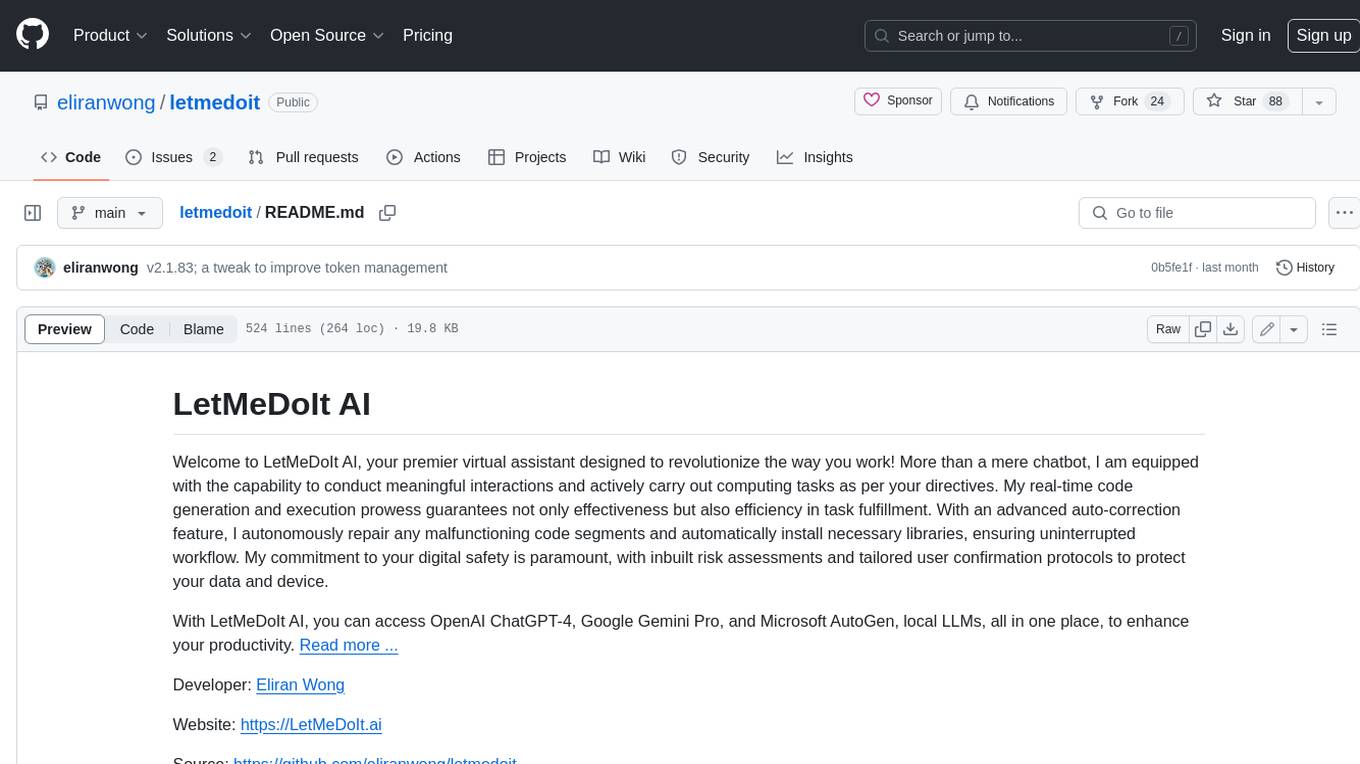
letmedoit
LetMeDoIt AI is a virtual assistant designed to revolutionize the way you work. It goes beyond being a mere chatbot by offering a unique and powerful capability - the ability to execute commands and perform computing tasks on your behalf. With LetMeDoIt AI, you can access OpenAI ChatGPT-4, Google Gemini Pro, and Microsoft AutoGen, local LLMs, all in one place, to enhance your productivity.
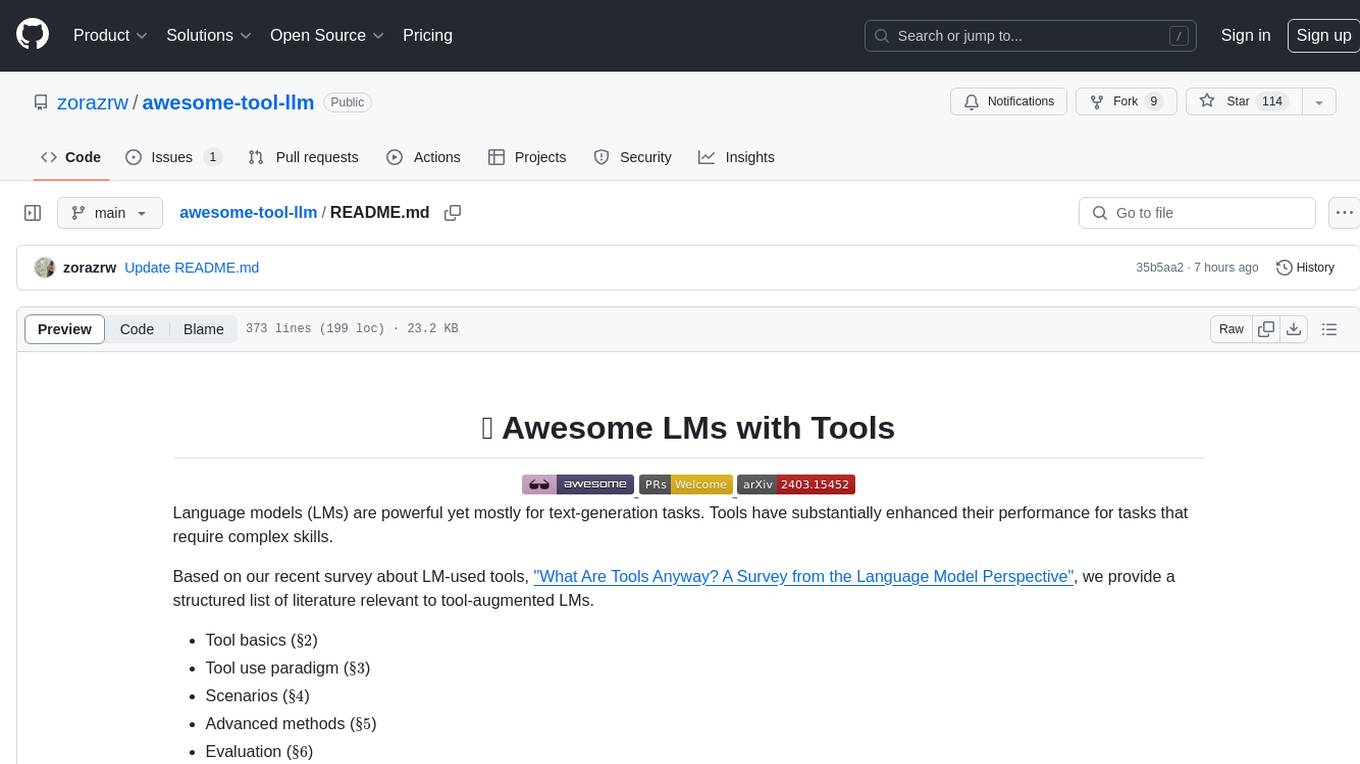
awesome-tool-llm
This repository focuses on exploring tools that enhance the performance of language models for various tasks. It provides a structured list of literature relevant to tool-augmented language models, covering topics such as tool basics, tool use paradigm, scenarios, advanced methods, and evaluation. The repository includes papers, preprints, and books that discuss the use of tools in conjunction with language models for tasks like reasoning, question answering, mathematical calculations, accessing knowledge, interacting with the world, and handling non-textual modalities.
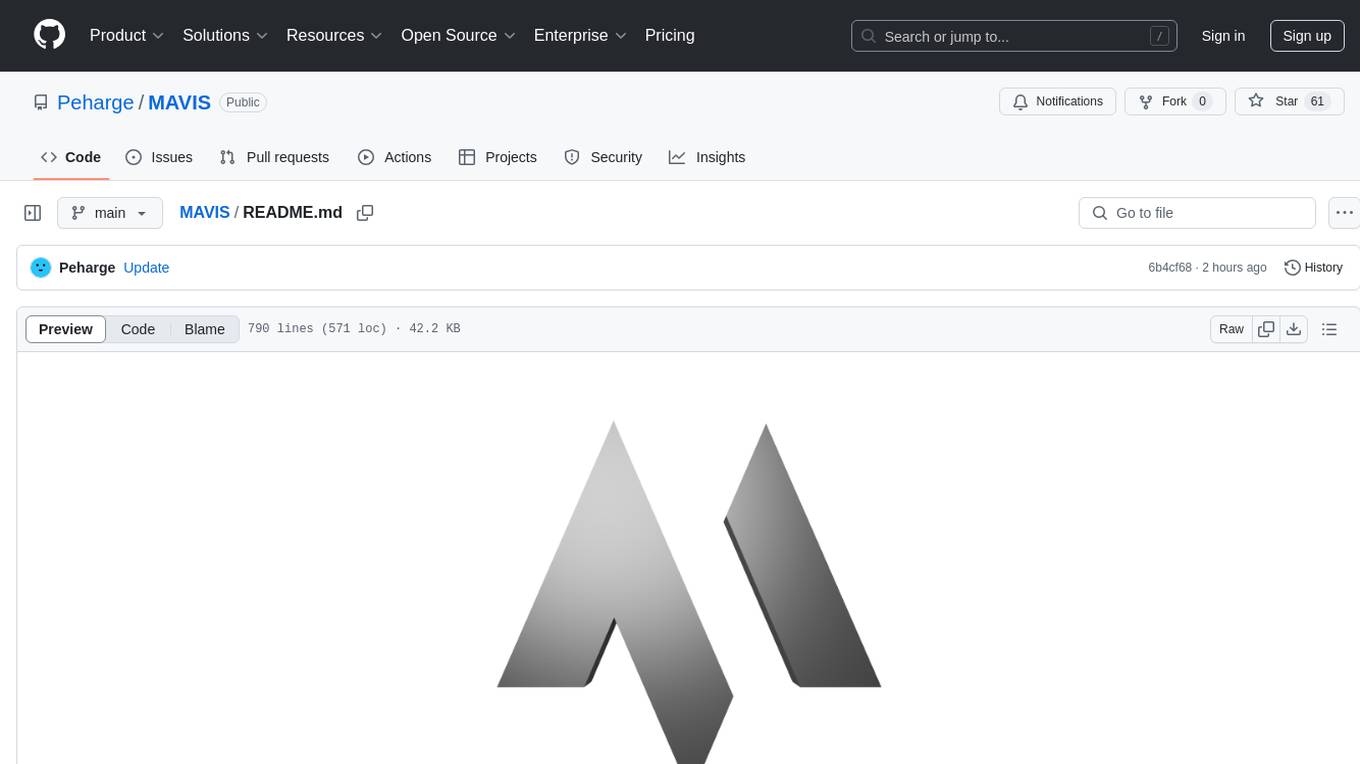
MAVIS
MAVIS (Math Visual Intelligent System) is an AI-driven application that allows users to analyze visual data such as images and generate interactive answers based on them. It can perform complex mathematical calculations, solve programming tasks, and create professional graphics. MAVIS supports Python for coding and frameworks like Matplotlib, Plotly, Seaborn, Altair, NumPy, Math, SymPy, and Pandas. It is designed to make projects more efficient and professional.
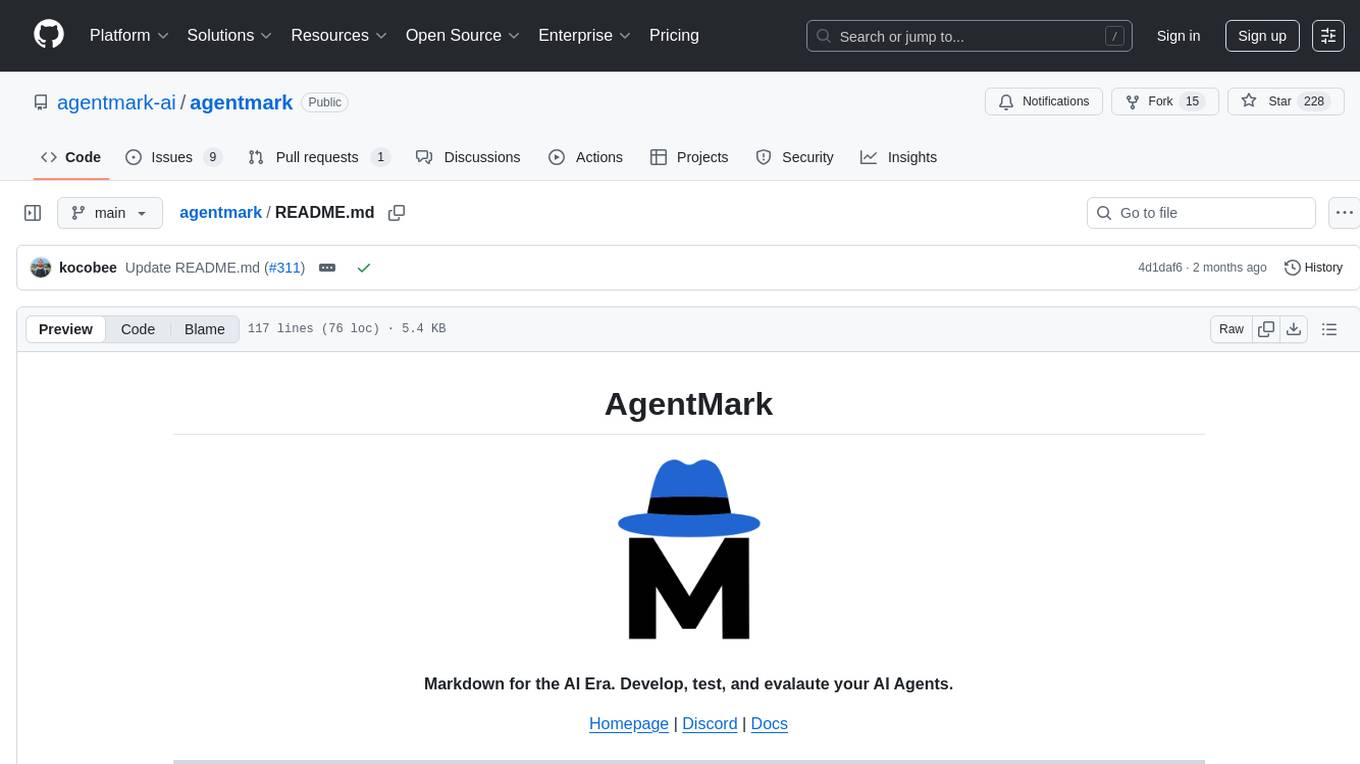
agentmark
AgentMark is a tool designed to make it easy for developers to develop, test, and evaluate AI Agents. It combines Markdown syntax with JSX components to create reliable Agents. The tool seamlessly integrates with SDKs, offering comprehensive tooling such as full type safety, unified prompt configuration, syntax highlighting, loops and conditionals, custom SDK adapters, and support for text, object, image, and speech generation across multiple model providers.
For similar jobs
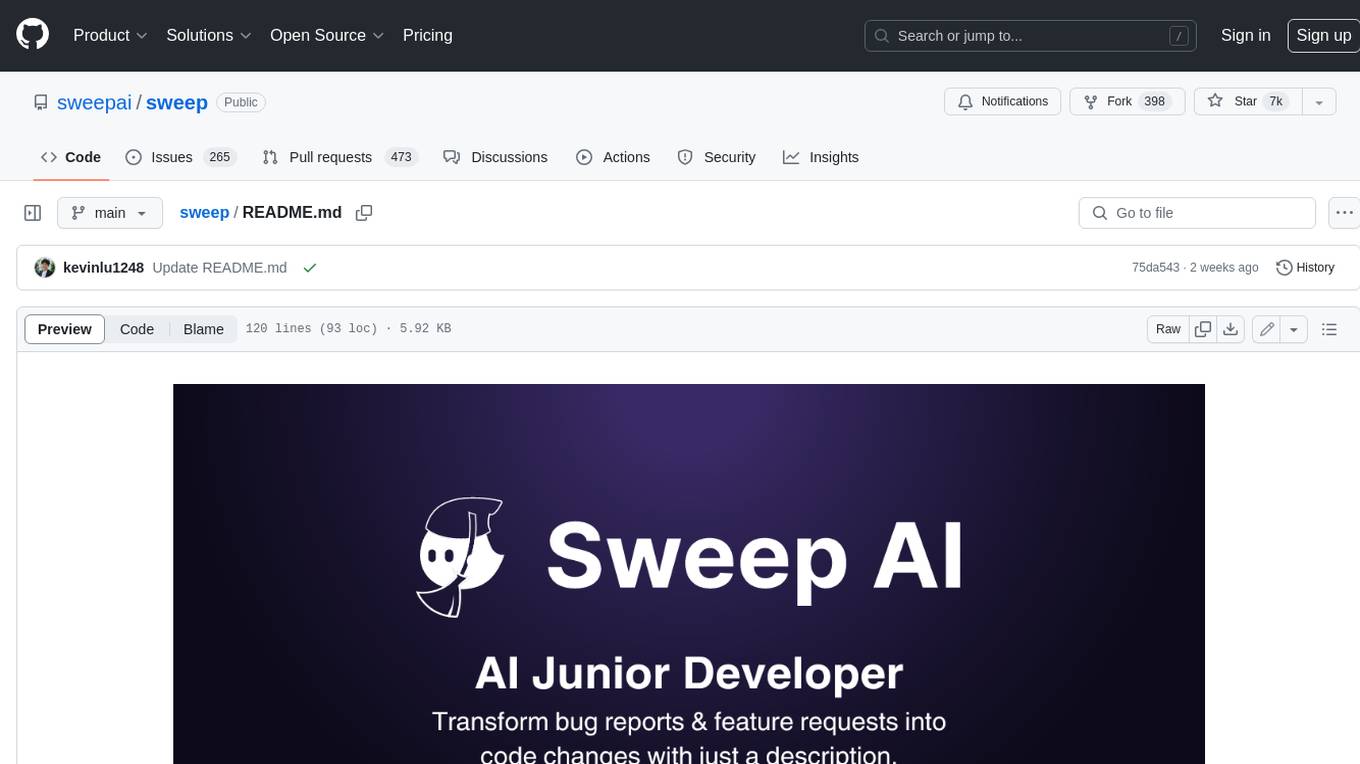
sweep
Sweep is an AI junior developer that turns bugs and feature requests into code changes. It automatically handles developer experience improvements like adding type hints and improving test coverage.
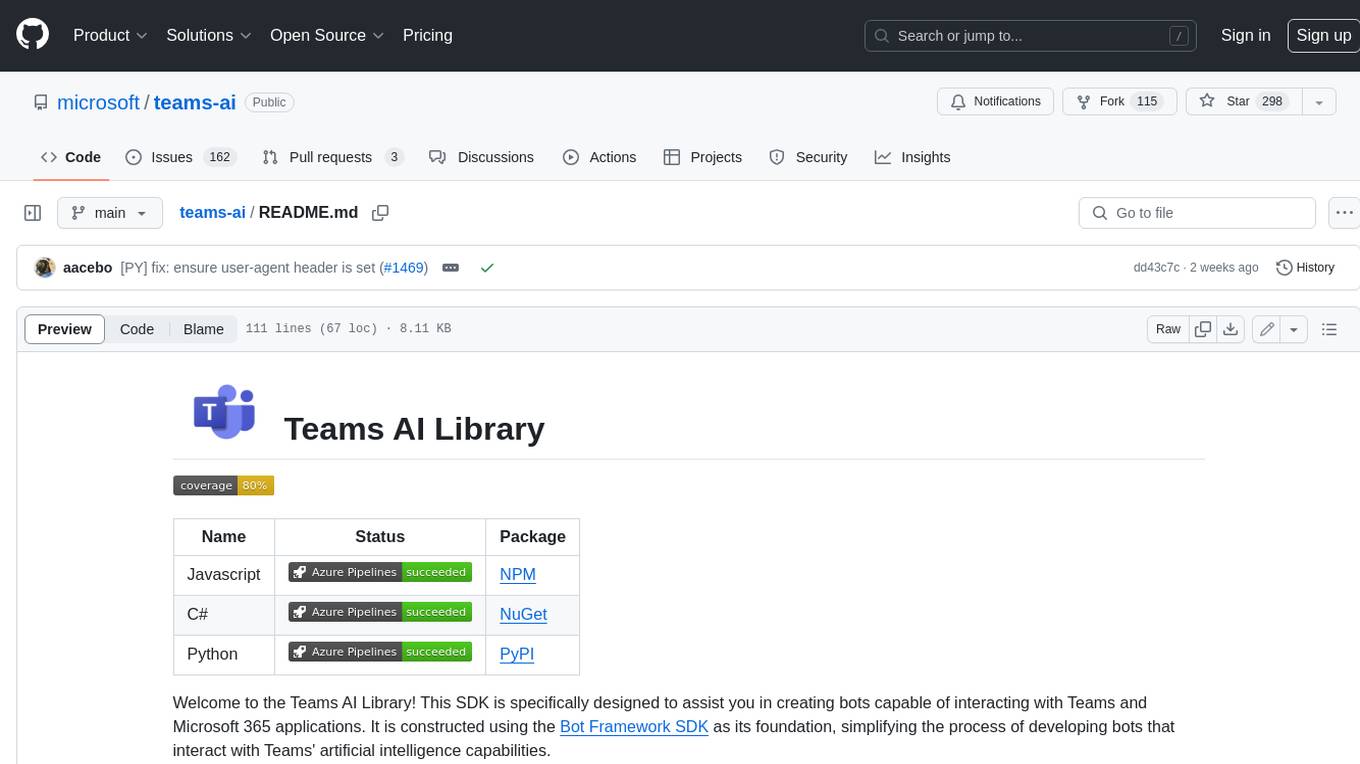
teams-ai
The Teams AI Library is a software development kit (SDK) that helps developers create bots that can interact with Teams and Microsoft 365 applications. It is built on top of the Bot Framework SDK and simplifies the process of developing bots that interact with Teams' artificial intelligence capabilities. The SDK is available for JavaScript/TypeScript, .NET, and Python.
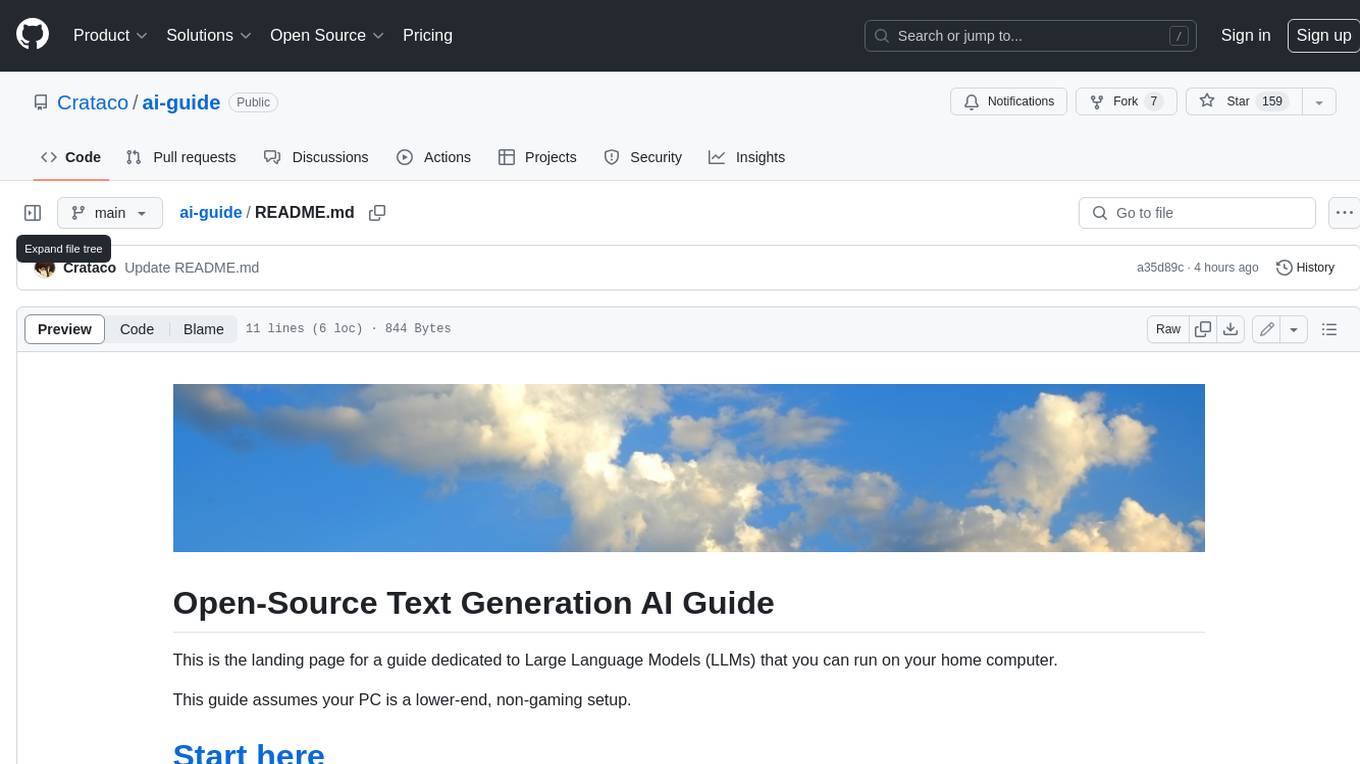
ai-guide
This guide is dedicated to Large Language Models (LLMs) that you can run on your home computer. It assumes your PC is a lower-end, non-gaming setup.
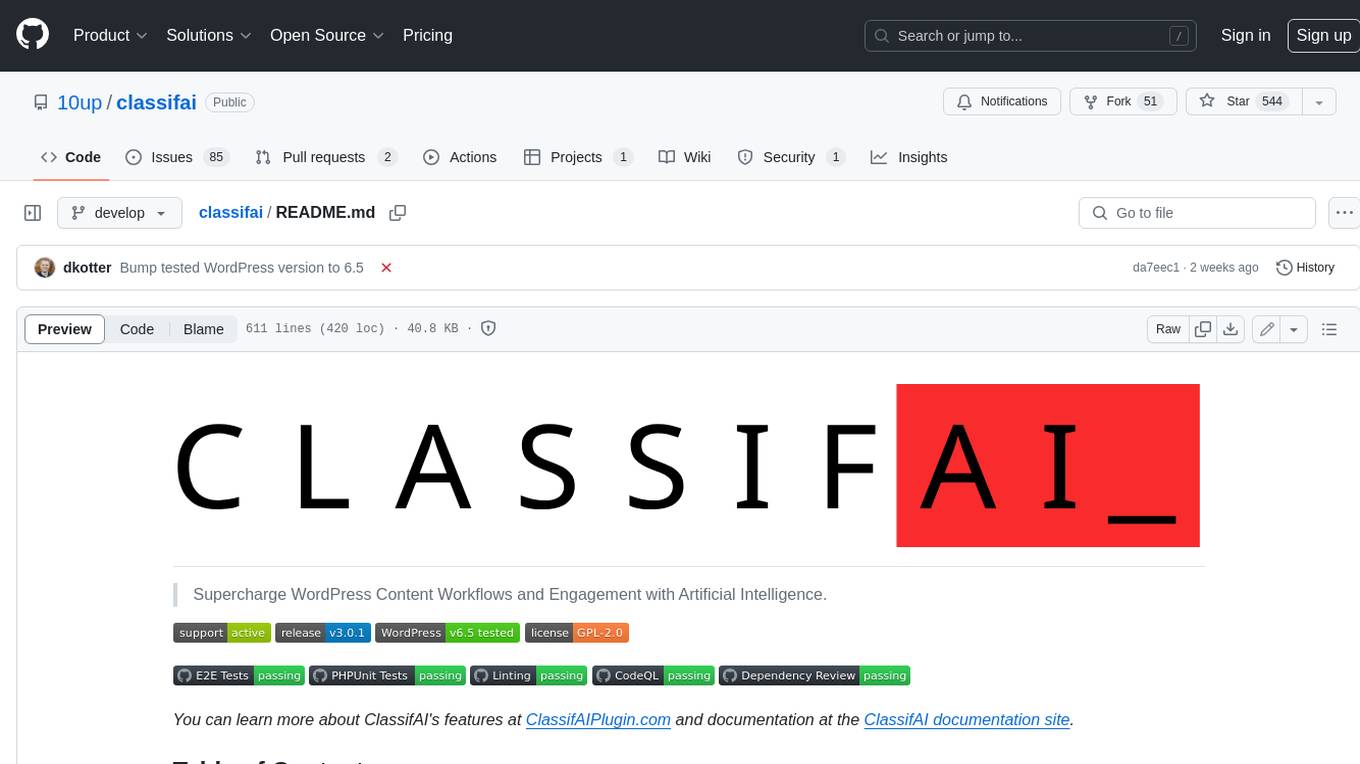
classifai
Supercharge WordPress Content Workflows and Engagement with Artificial Intelligence. Tap into leading cloud-based services like OpenAI, Microsoft Azure AI, Google Gemini and IBM Watson to augment your WordPress-powered websites. Publish content faster while improving SEO performance and increasing audience engagement. ClassifAI integrates Artificial Intelligence and Machine Learning technologies to lighten your workload and eliminate tedious tasks, giving you more time to create original content that matters.
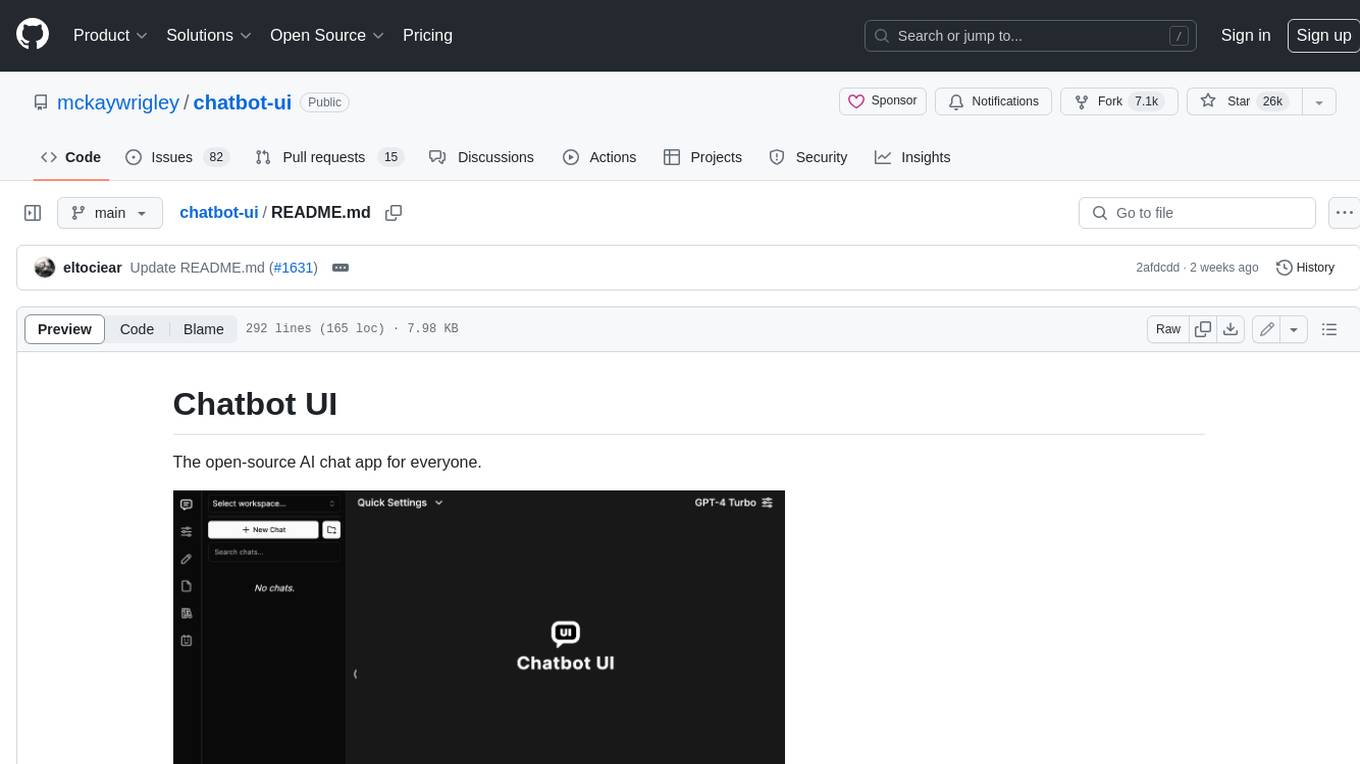
chatbot-ui
Chatbot UI is an open-source AI chat app that allows users to create and deploy their own AI chatbots. It is easy to use and can be customized to fit any need. Chatbot UI is perfect for businesses, developers, and anyone who wants to create a chatbot.
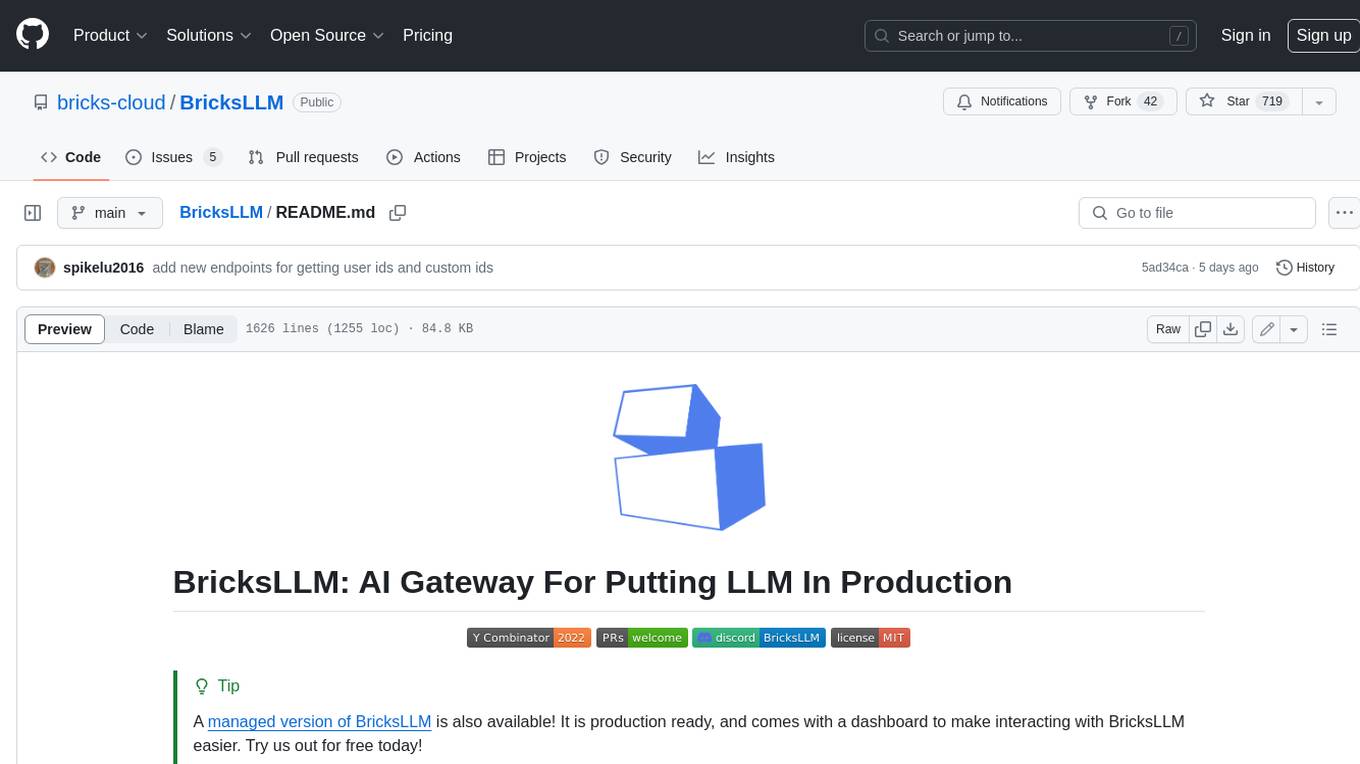
BricksLLM
BricksLLM is a cloud native AI gateway written in Go. Currently, it provides native support for OpenAI, Anthropic, Azure OpenAI and vLLM. BricksLLM aims to provide enterprise level infrastructure that can power any LLM production use cases. Here are some use cases for BricksLLM: * Set LLM usage limits for users on different pricing tiers * Track LLM usage on a per user and per organization basis * Block or redact requests containing PIIs * Improve LLM reliability with failovers, retries and caching * Distribute API keys with rate limits and cost limits for internal development/production use cases * Distribute API keys with rate limits and cost limits for students
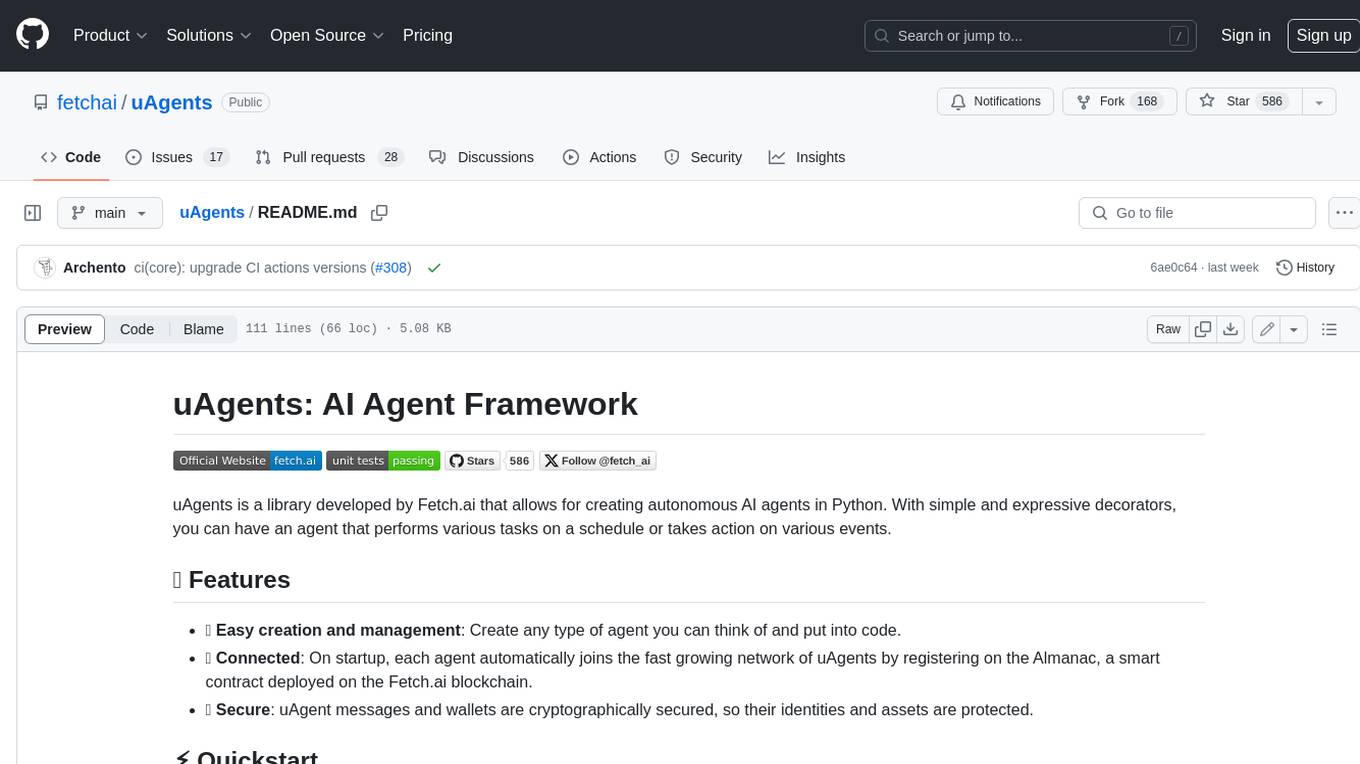
uAgents
uAgents is a Python library developed by Fetch.ai that allows for the creation of autonomous AI agents. These agents can perform various tasks on a schedule or take action on various events. uAgents are easy to create and manage, and they are connected to a fast-growing network of other uAgents. They are also secure, with cryptographically secured messages and wallets.
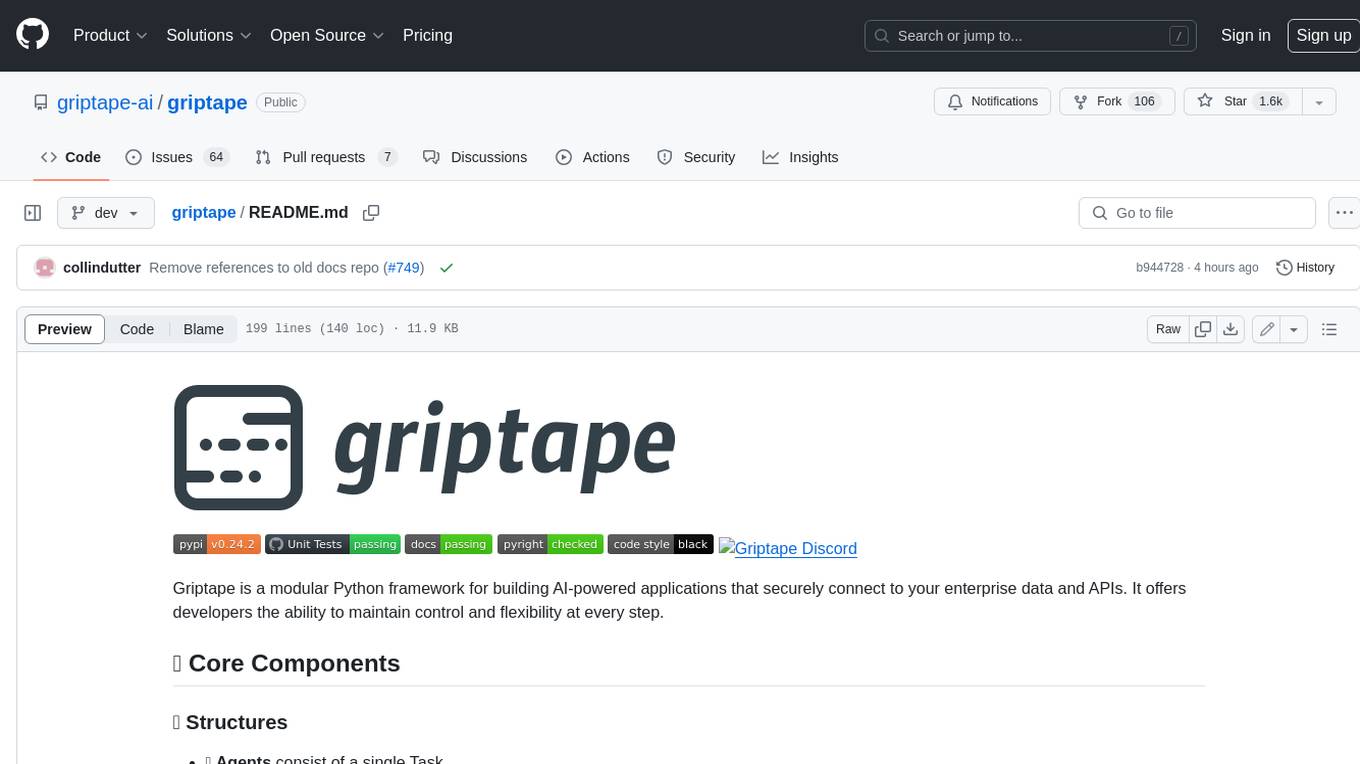
griptape
Griptape is a modular Python framework for building AI-powered applications that securely connect to your enterprise data and APIs. It offers developers the ability to maintain control and flexibility at every step. Griptape's core components include Structures (Agents, Pipelines, and Workflows), Tasks, Tools, Memory (Conversation Memory, Task Memory, and Meta Memory), Drivers (Prompt and Embedding Drivers, Vector Store Drivers, Image Generation Drivers, Image Query Drivers, SQL Drivers, Web Scraper Drivers, and Conversation Memory Drivers), Engines (Query Engines, Extraction Engines, Summary Engines, Image Generation Engines, and Image Query Engines), and additional components (Rulesets, Loaders, Artifacts, Chunkers, and Tokenizers). Griptape enables developers to create AI-powered applications with ease and efficiency.